After the spontaneous lunch and upon returning to the flat parts of Chiang Mai, I continued walking towards the old part of the city. As mentioned earlier, the old part of the city has an almost perfect square layout and it is surrounded by a wide moat where water can still be seen today. My plan was to enter this part of the city through Suan Dok Gate and as I approached it, I first noticed an old and relatively neglected chedi on one side of the street within the courtyard belonging to some archives. This just goes to show how many such structures there are throughout Chiang Mai. As I’ve mentioned earlier, there are over 300 temples in the city and its surroundings.
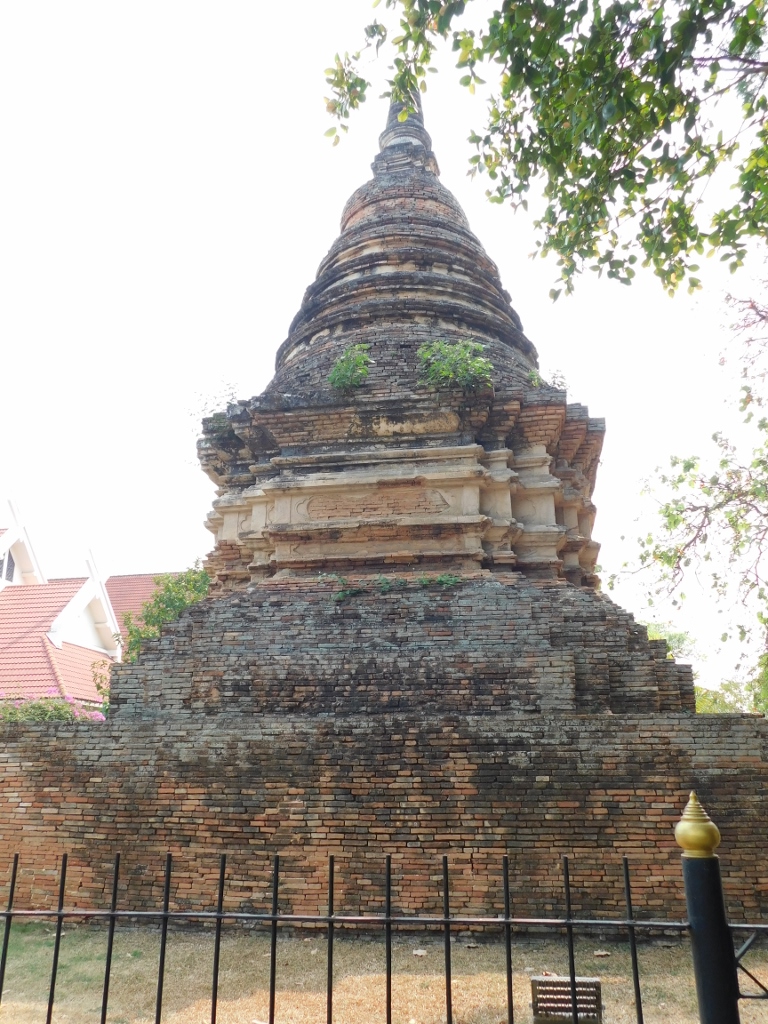 Chiang Mai, a detail
Chiang Mai, a detail
My next destination was the temple considered the most beautiful in Chiang Mai and certainly one of the most important. But first, I passed by the well-maintained moat and then through the remains of the western gate that led to the capital of the ancient Lan Na Kingdom.
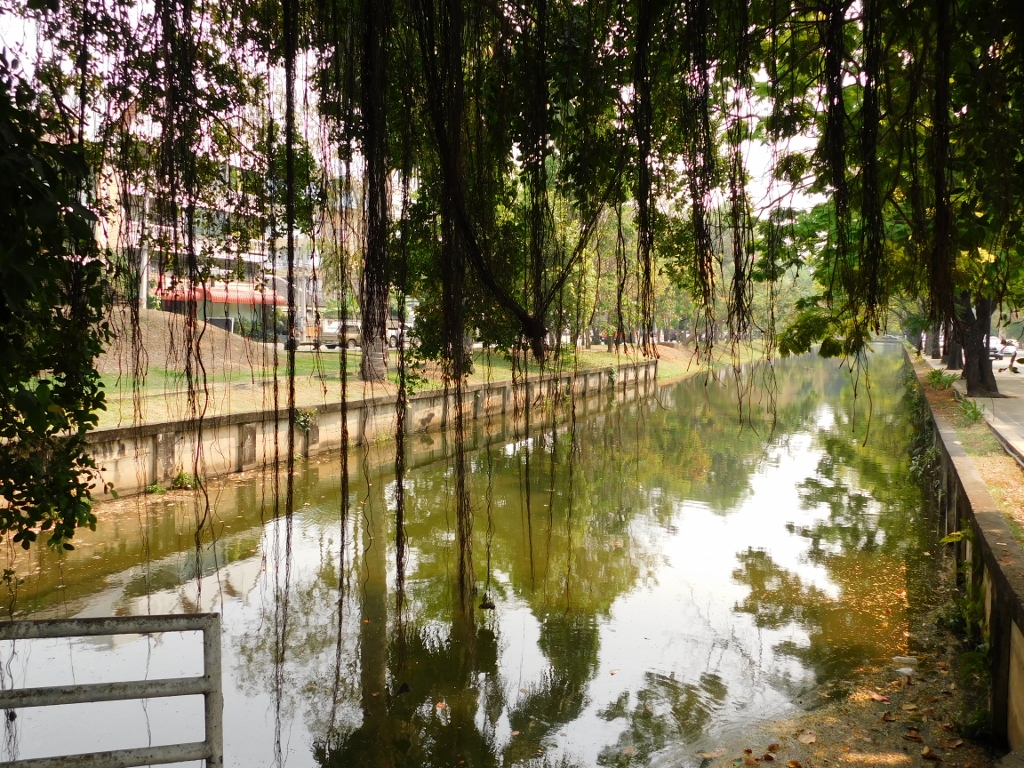 Moat around the old part of Chiang Mai
Moat around the old part of Chiang Mai
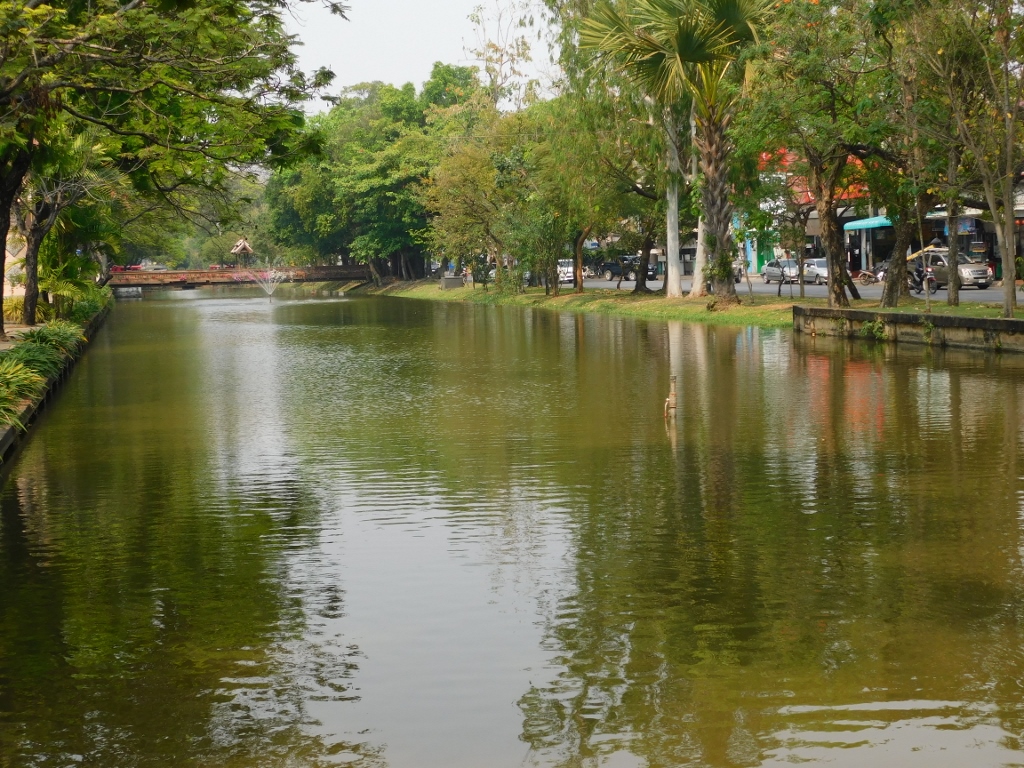 Moat around the old part of Chiang Mai
Moat around the old part of Chiang Mai
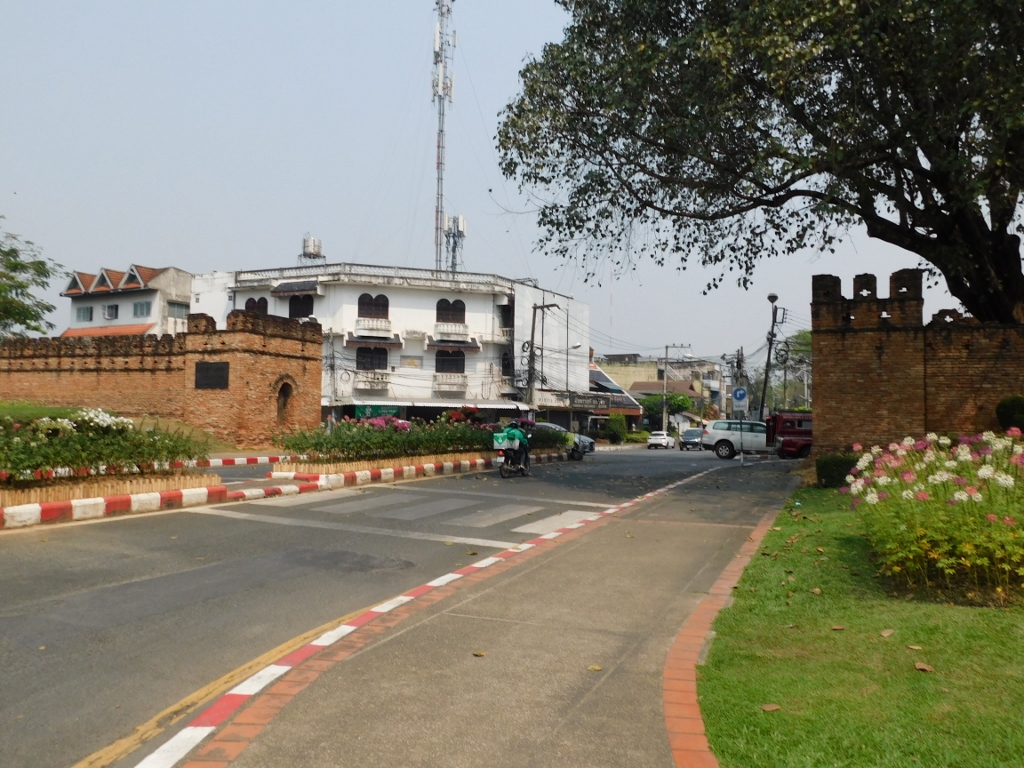 Suan Dok Gate and a contemporary street that leads to the western part of the ancient Chiang Mai
Suan Dok Gate and a contemporary street that leads to the western part of the ancient Chiang Mai
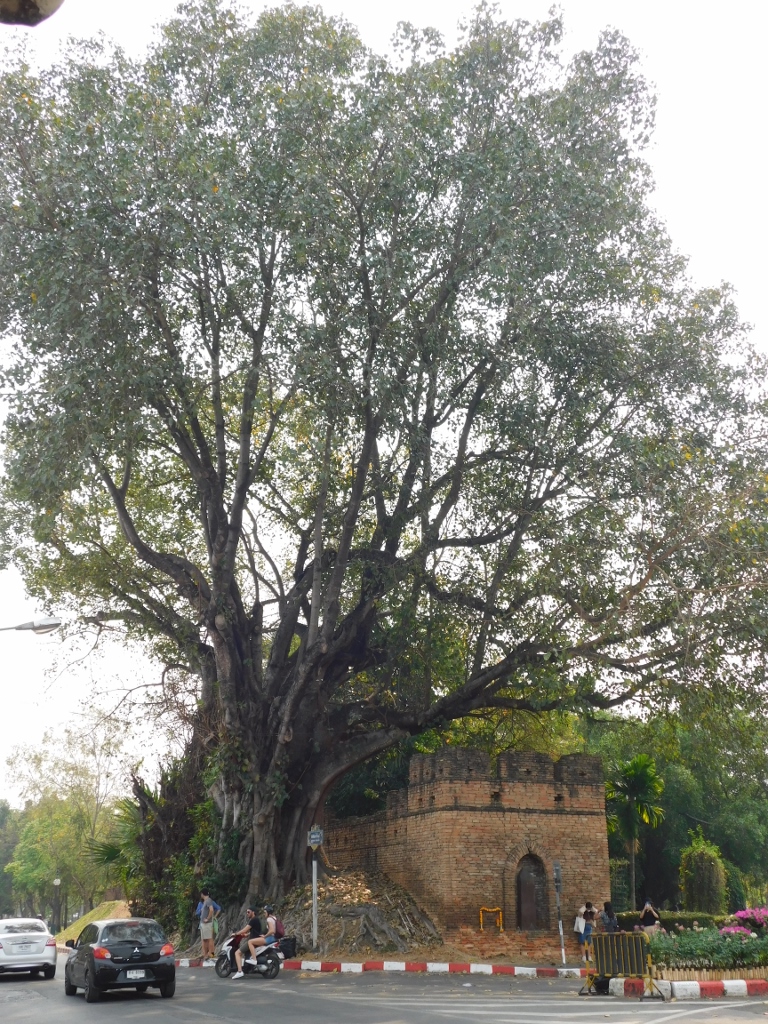 An impressive tree and the Suan Dok Gate
An impressive tree and the Suan Dok Gate
Still, before reaching the temple I was heading to, I passed by a place that seemed like a modern shrine dedicated to spare parts for cars.
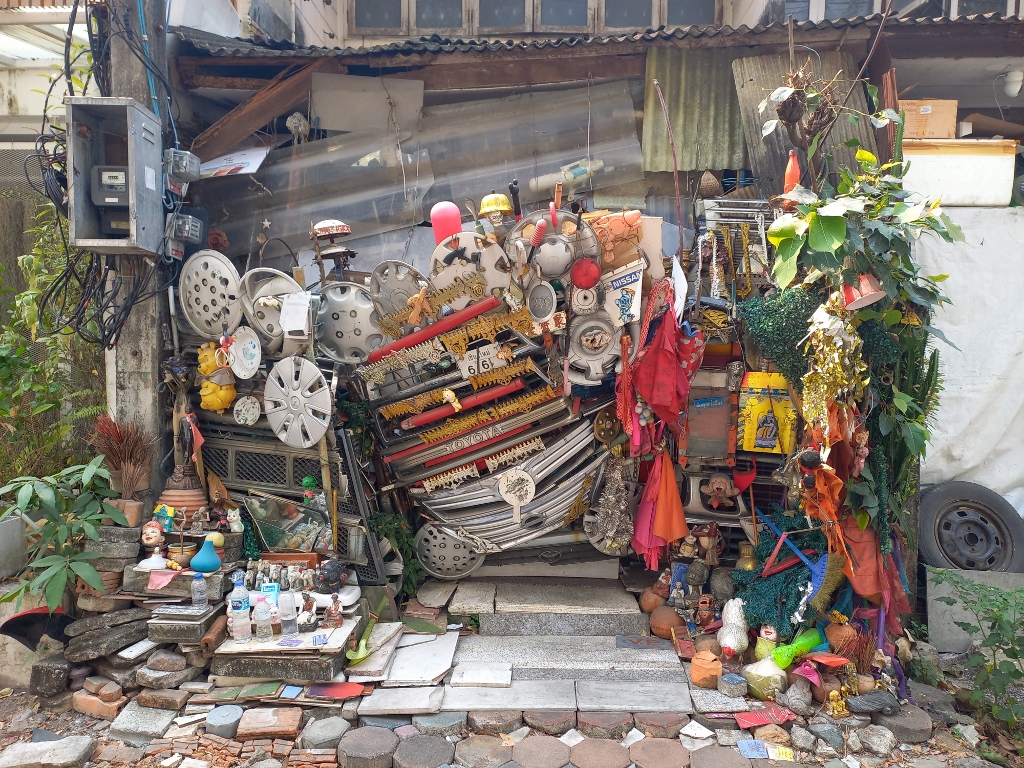 Chiang Mai, a detail
Chiang Mai, a detail
The temple I planned to visit is called Wat Phra Singh. I approached it from the rear, the western side, where within the temple complex there is a Lotus Pond with large decorative kois.
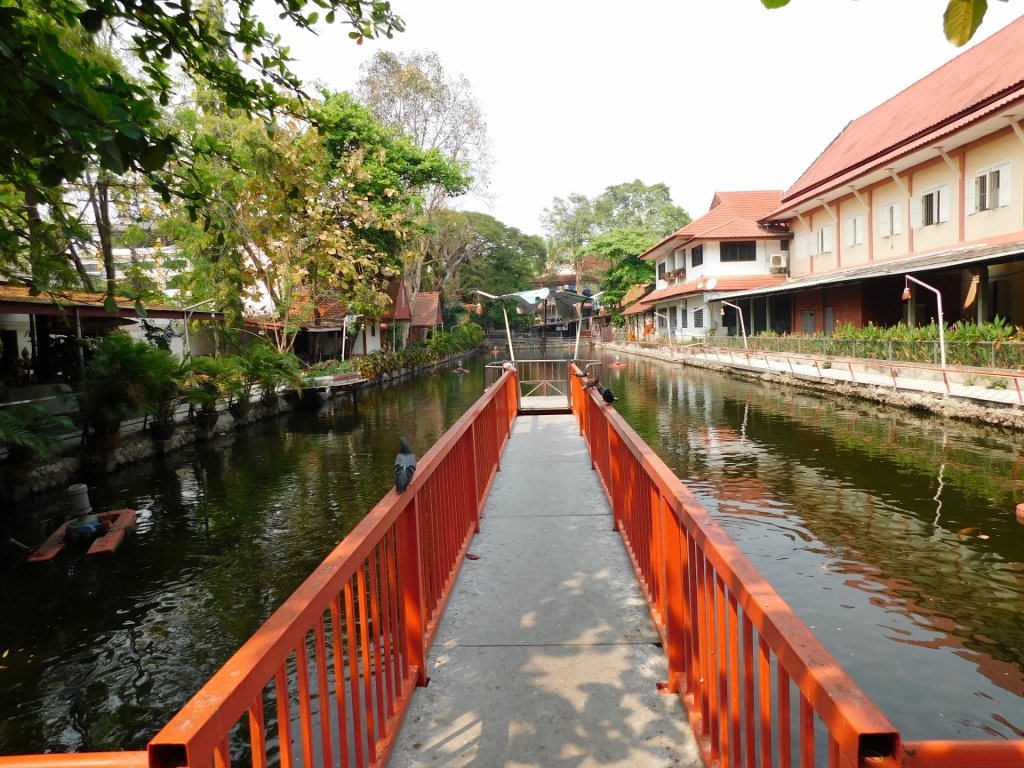 Wat Phra Singh, a detail
Wat Phra Singh, a detail
Just a few dozen metres further, some of the most significant structures within the temple complex come into view.
 Wat Phra Singh
Wat Phra Singh
The temple was founded in the 14th century and it is still active today with hundreds of monks residing here. I started to explore all the structures one by one, so I first came across a smaller vihara for which I couldn’t find any specific information, while in the photo above it can be seen on the right-hand side.
 Wat Phra Singh, a detail
Wat Phra Singh, a detail
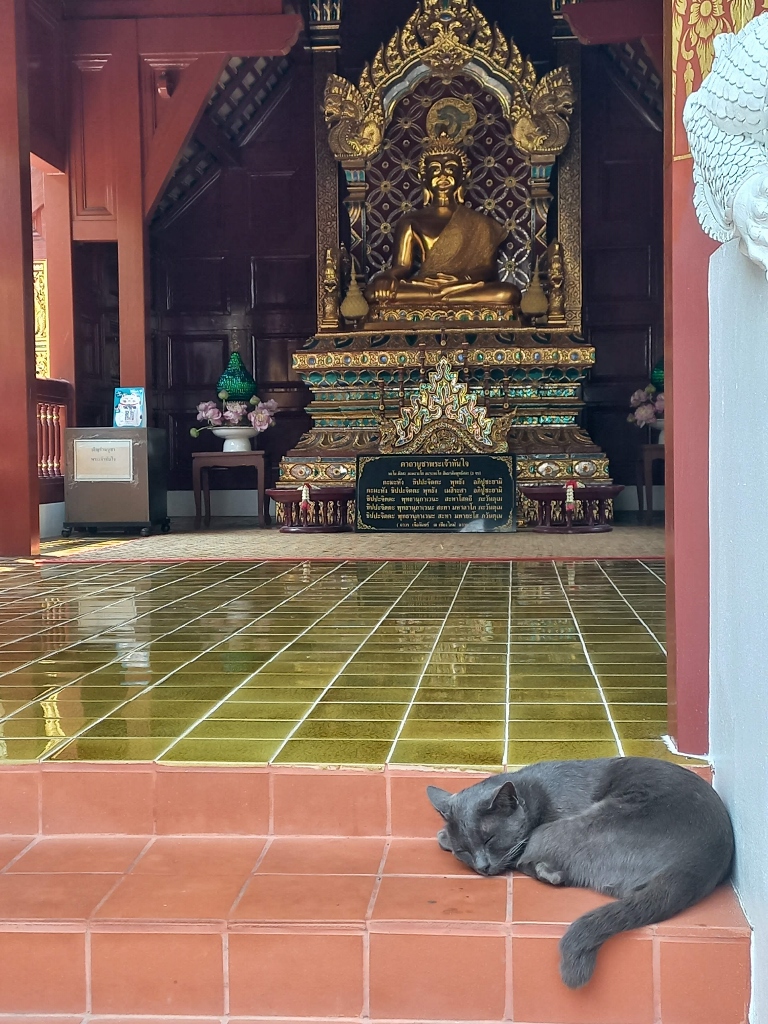 Wat Phra Singh, a detail
Wat Phra Singh, a detail
Directly across from this vihara, there is the Ku Lai chedi, built in the late 15th or early 16th century with a square plan and as a five-storey pagoda.
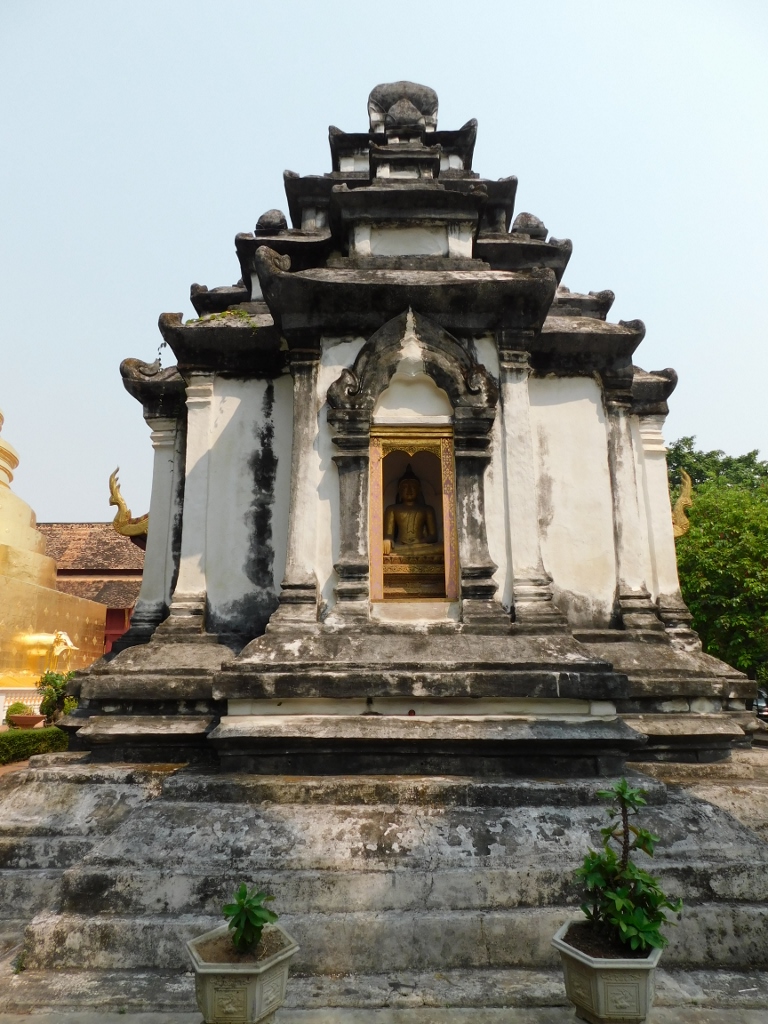 Wat Phra Singh, Ku Lai chedi
Wat Phra Singh, Ku Lai chedi
From here, I could see the impressive main chedi, shining with its golden colour under the sun breaking through the haze. However, I resisted the urge to head directly there and instead went to a smaller structure called the Reclining Buddha Temple.
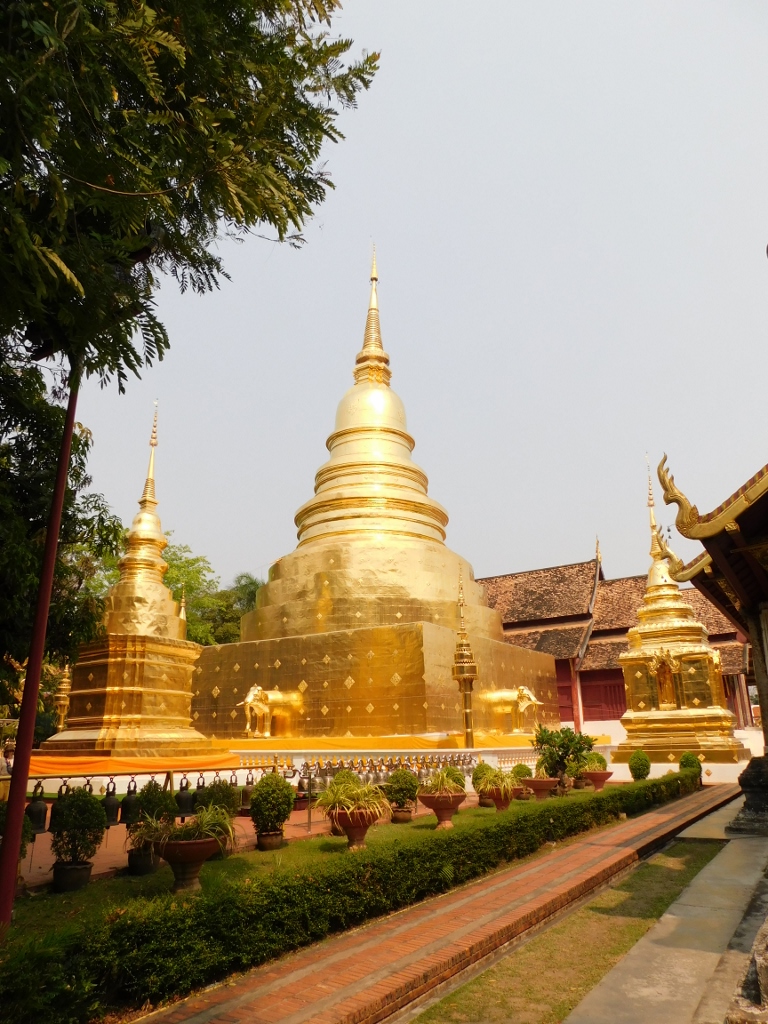 Wat Phra Singh, a detail
Wat Phra Singh, a detail
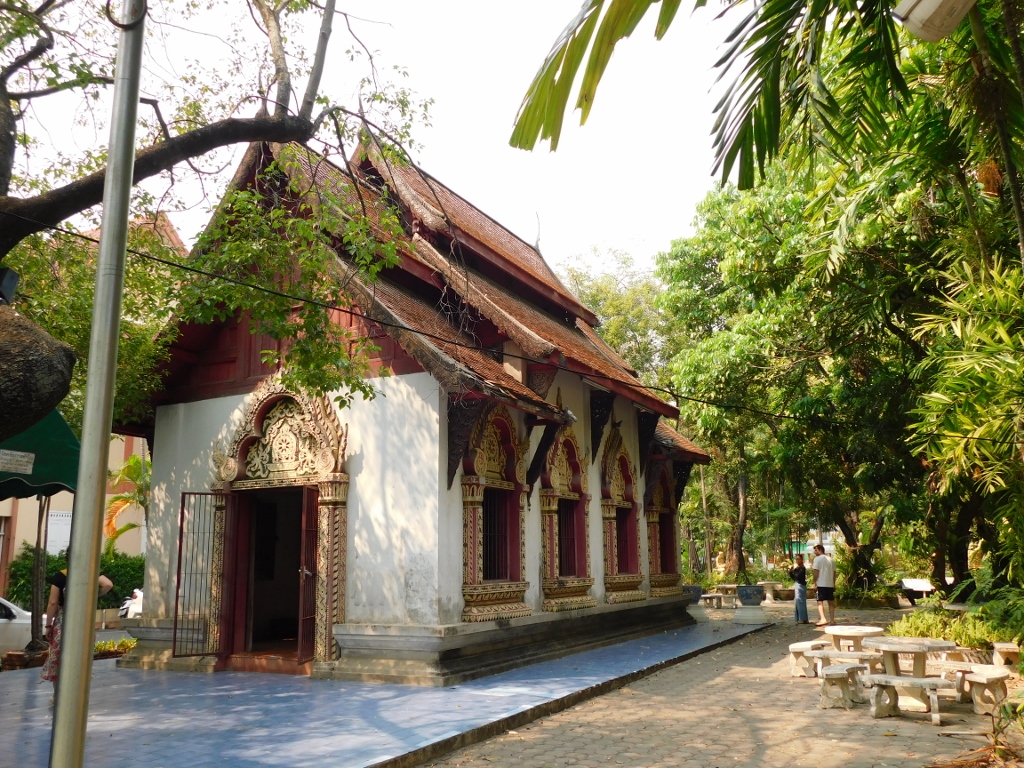 Wat Phra Singh, Reclining Buddha Temple
Wat Phra Singh, Reclining Buddha Temple
The reason for this name is quite obvious. Inside this structure with a rectangular ground plan, there is a large statue of the reclining Buddha.
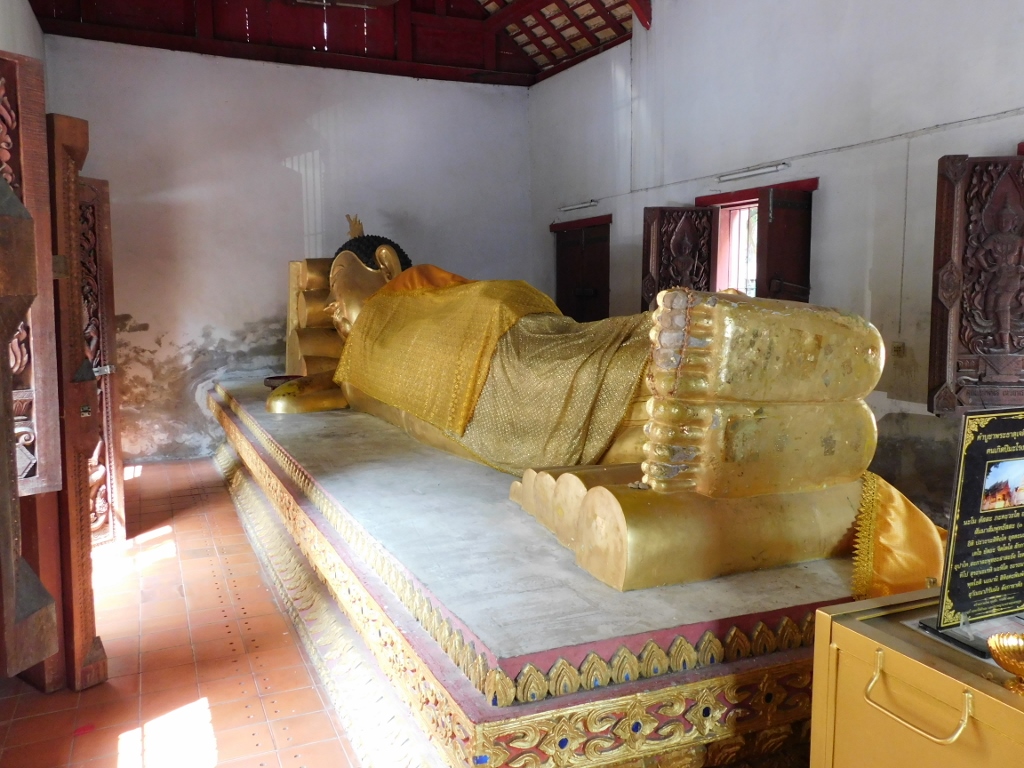 Wat Phra Singh, Reclining Buddha Temple, a detail
Wat Phra Singh, Reclining Buddha Temple, a detail
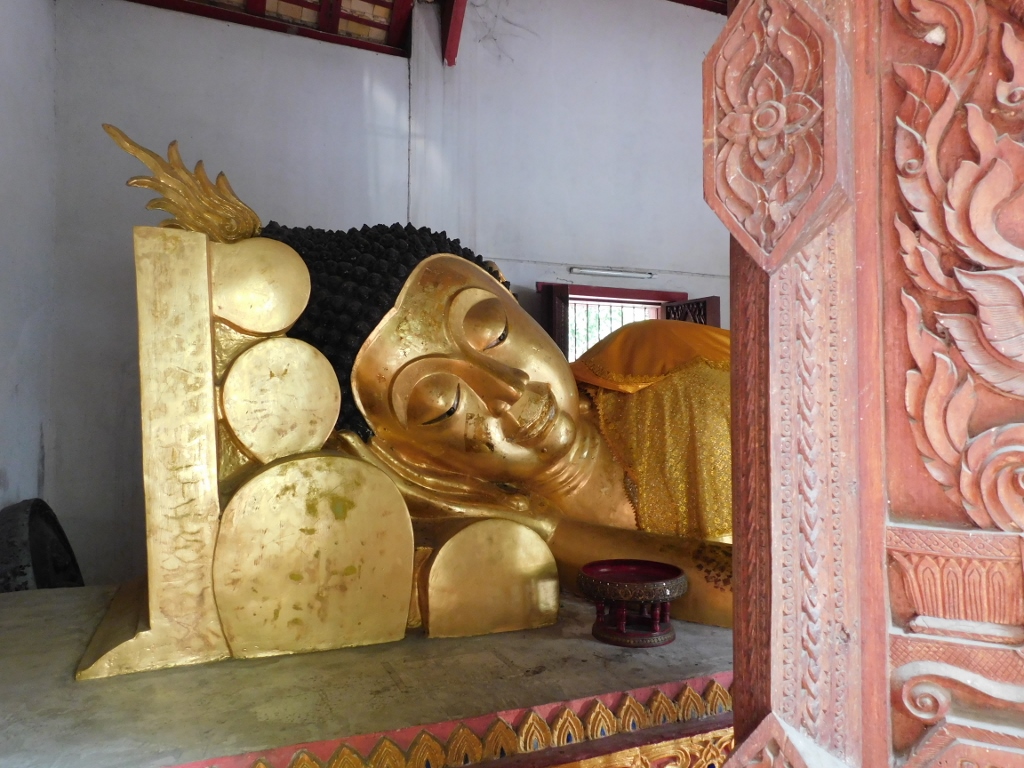 Wat Phra Singh, Reclining Buddha Temple, a detail
Wat Phra Singh, Reclining Buddha Temple, a detail
Right next to this temple, and still within the temple complex, there is a plateau with benches where one can sit and rest. However, I was a woman on a mission, so any rest here was still out of the question.
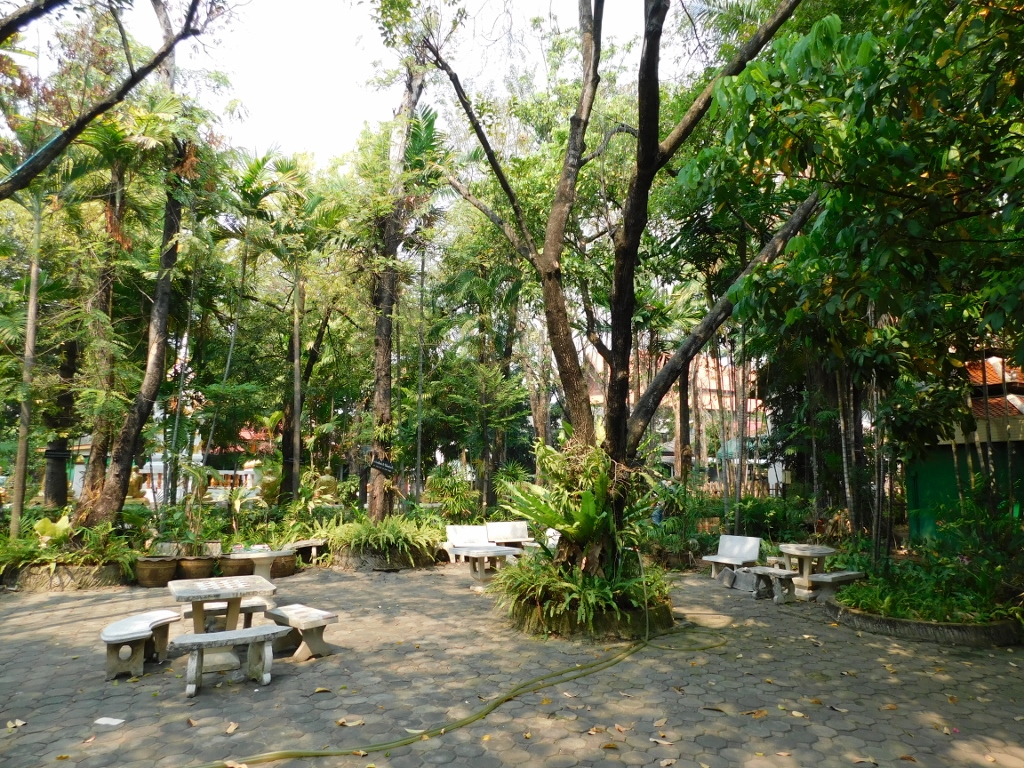 Wat Phra Singh, a detail
Wat Phra Singh, a detail
Now I was ready to pay more attention to the main chedi, which is surrounded on three sides by smaller chedis. Everything is covered in golden colour and gleams brightly.
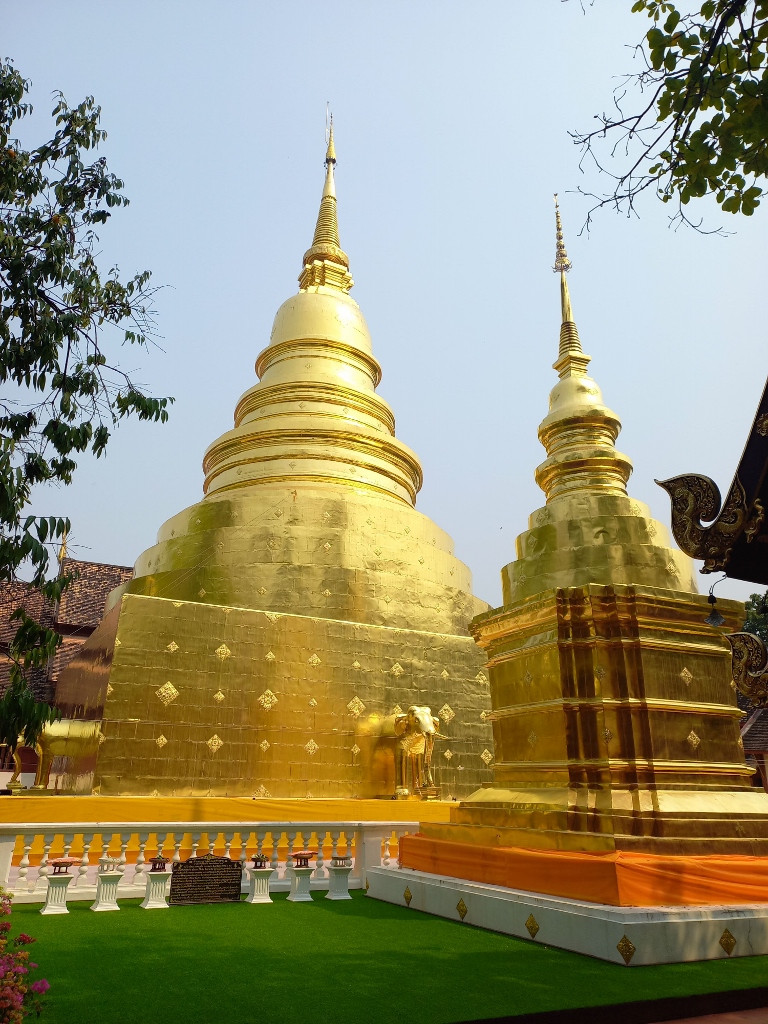 Wat Phra Singh, main chedi and the west small chedi
Wat Phra Singh, main chedi and the west small chedi
The main chedi is the oldest structure within the temple and was built in 1345, although it was smaller at that time. It is round and set on a square base, with a figure of an elephant emerging from the chedi on each side of the base. I found it interesting to read in an older guidebook about the “white chedi” and elephants crafted in the stucco technique and, later, I also saw photos on the internet confirming this. It simply means that the main chedi and its details, as well as the smaller chedis, were repainted meanwhile with golden colour that is so popular.
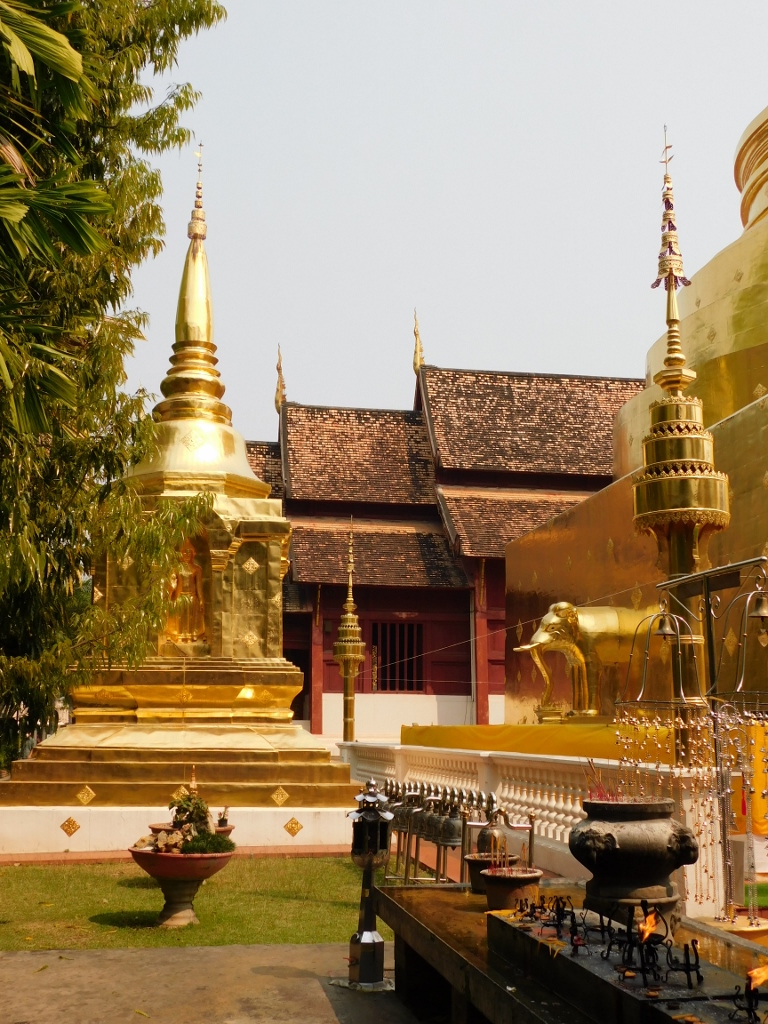 Wat Phra Singh, details of the main chedi and the north small chedi
Wat Phra Singh, details of the main chedi and the north small chedi
Now I came to the section of the ubosot that seemed like the back, so I entered from that side.
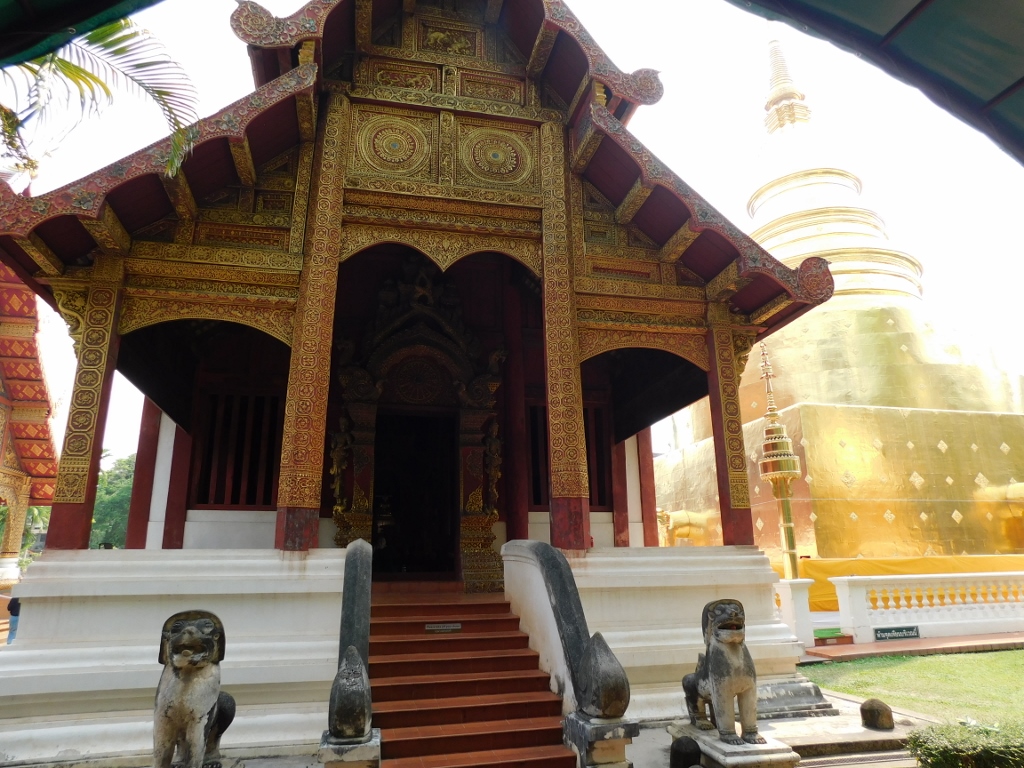 Wat Phra Singh, ubosot
Wat Phra Singh, ubosot
This ubosot, built in 1806, is interesting because it has two designated entrances – the northern side entrance is for nuns, while the southern side entrance is for monks. In the centre of the ubosot, there is a kind of mondop with a figure of the Buddha.
It’s worth noting that Buddhists in Thailand hold their monks in high esteem, which is why it’s not surprising to see figures of monks in some temples, not just those of the Buddha. What may be surprising is that these figures are often crafted in an exceptionally realistic manner, almost as if a living person is seated here in meditation.
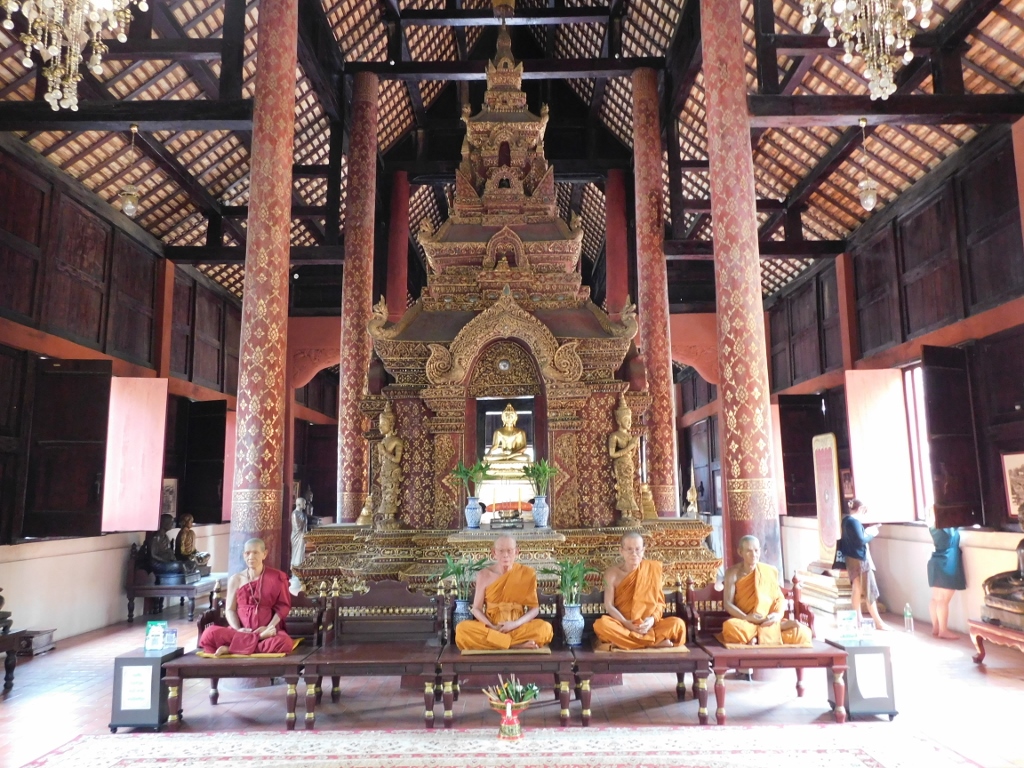 Wat Phra Singh, ubosot, a detail
Wat Phra Singh, ubosot, a detail
Here, I took advantage of the wide-open windows to admire once again the main chedi and the smaller northern chedi.
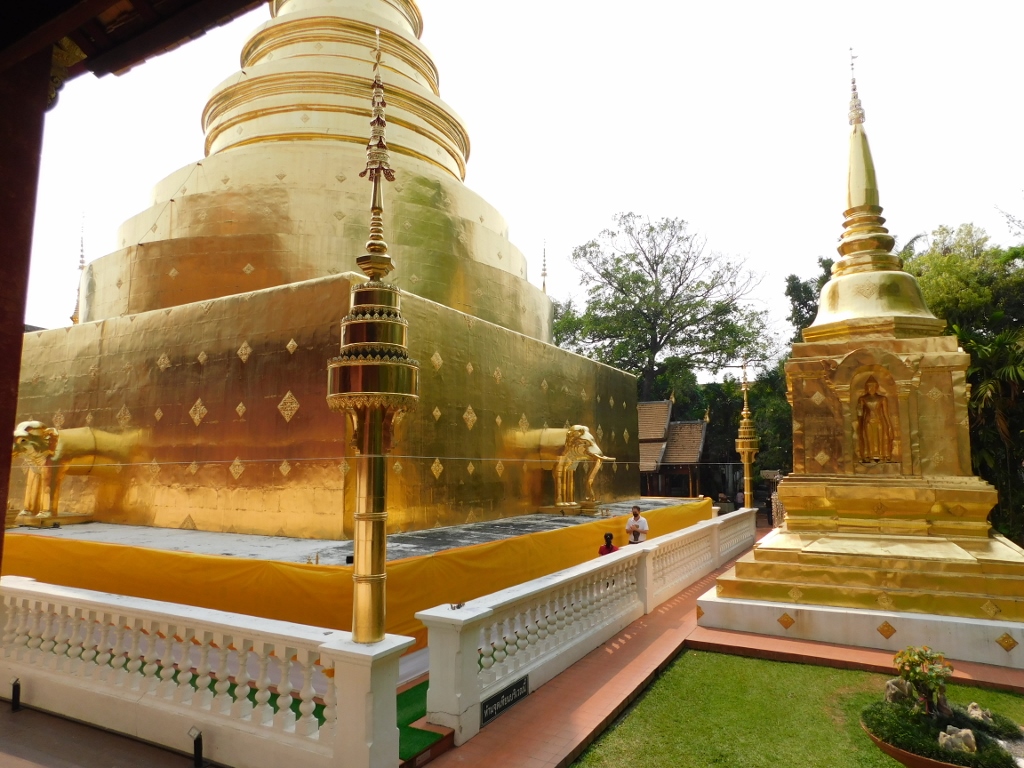 Wat Phra Singh, the main chedi and the northern small chedi
Wat Phra Singh, the main chedi and the northern small chedi
And then I went to the southern part of the ubosot where exceptionally realistic figures of monks were also arranged.
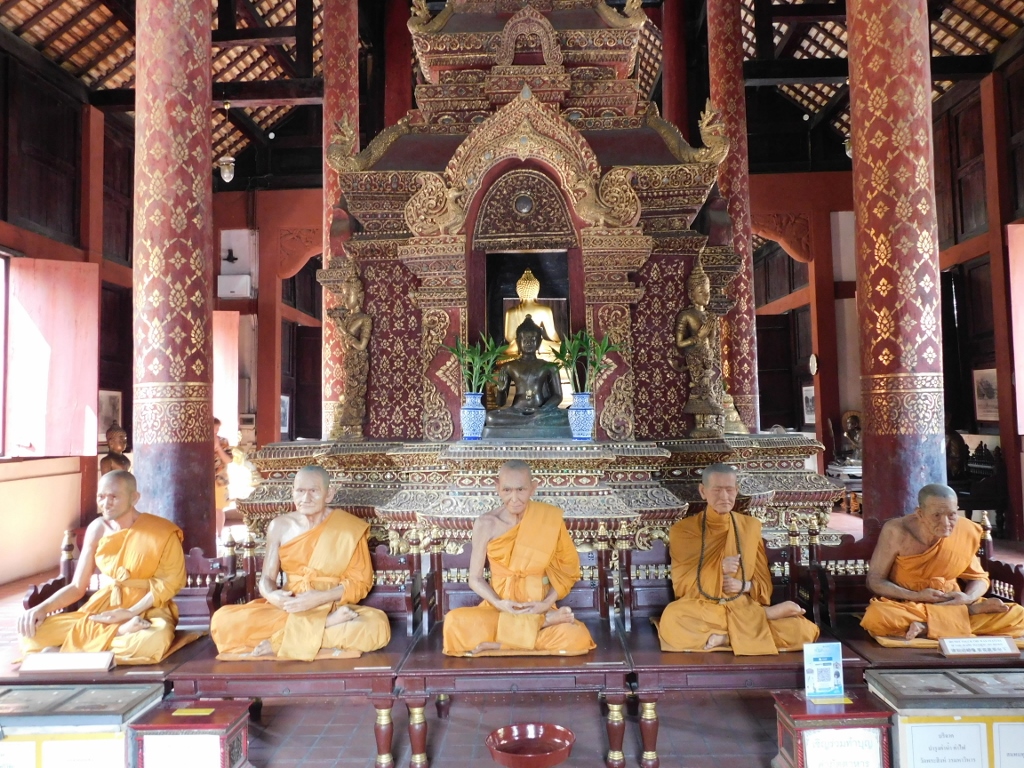 Wat Phra Singh, ubosot, a detail
Wat Phra Singh, ubosot, a detail
From there, I had to go back to the northern part as I left my footwear there. However, I then returned to the “front” part of the ubosot because I had a good view from there not only of the front, but also of some other parts of the temple.
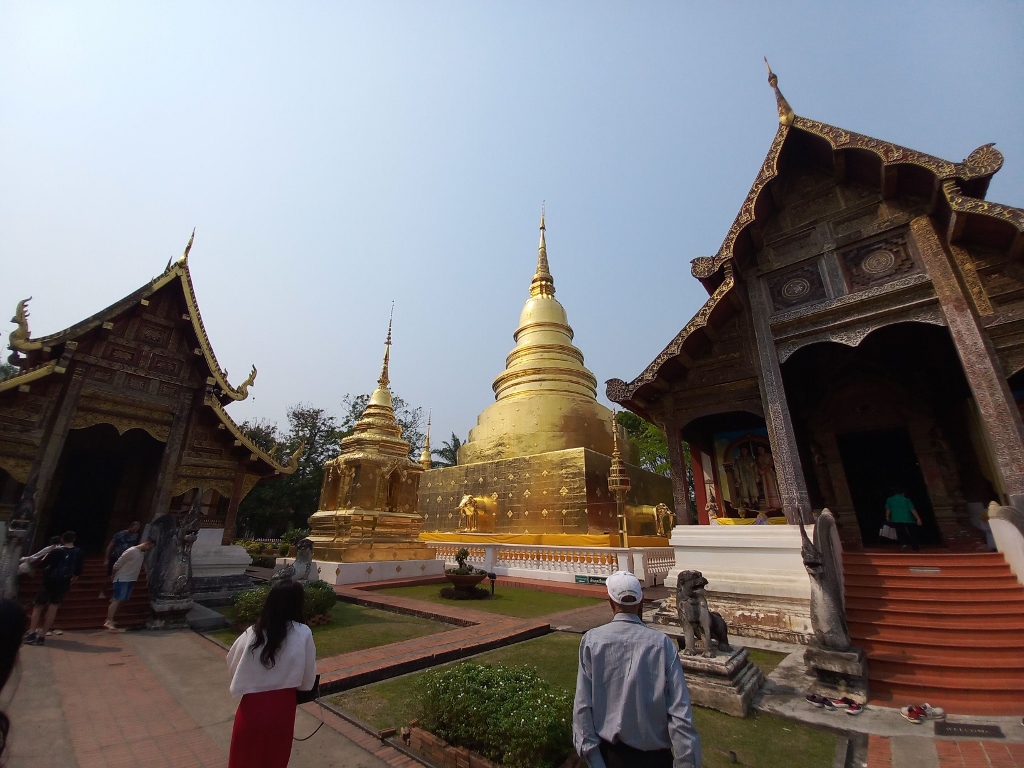 Wat Phra Singh: Vihara Lai Kham (left), the main chedi (middle) and the ubosot (right)
Wat Phra Singh: Vihara Lai Kham (left), the main chedi (middle) and the ubosot (right)
I would also like to mention that the ubosot has an exceptionally beautiful and richly decorated pediment, while on the sides, there are staircases decorated with Naga emerging from the jaws of Makara, a mythical sea creature. This reminded me of a similar composition I saw in southeast Thailand, but there, as it is explained, it was influenced by Khmer architecture. However, the Khmer influence was not present here in the early 19th century when this ubosot was constructed.
Be as it may, it undoubtedly represents Buddhist symbolism, indicating that Makaras serves as guardians of entrances and thresholds, meaning they also protect the ubosots.
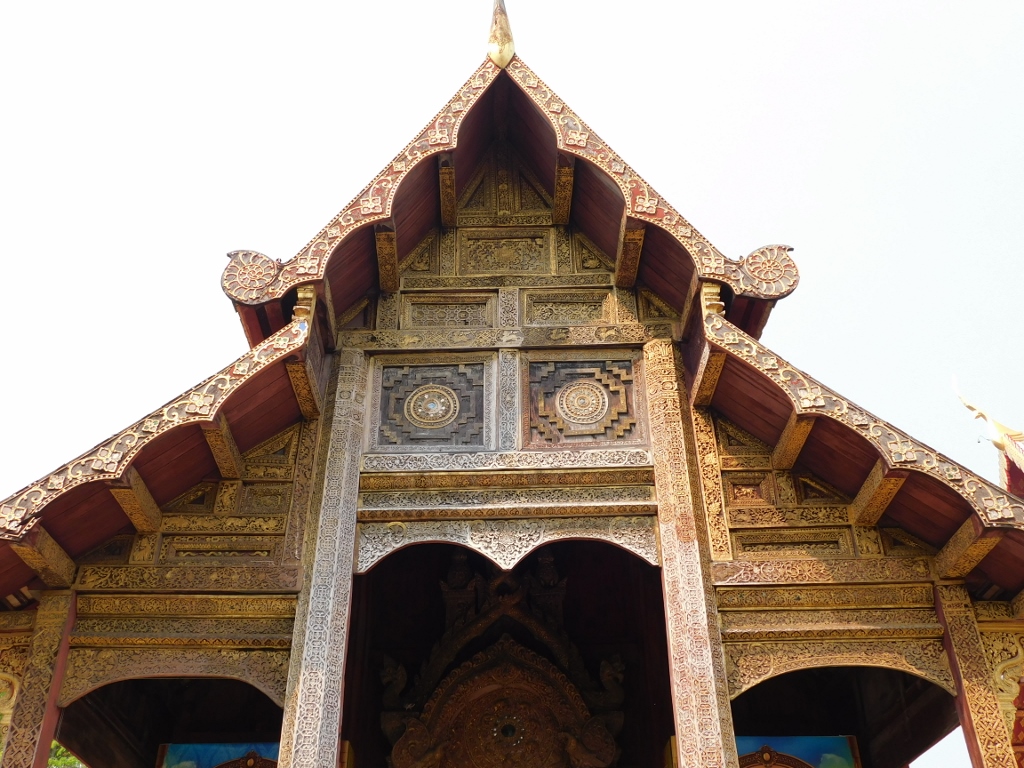 Wat Phra Singh, ubosot, a detail
Wat Phra Singh, ubosot, a detail
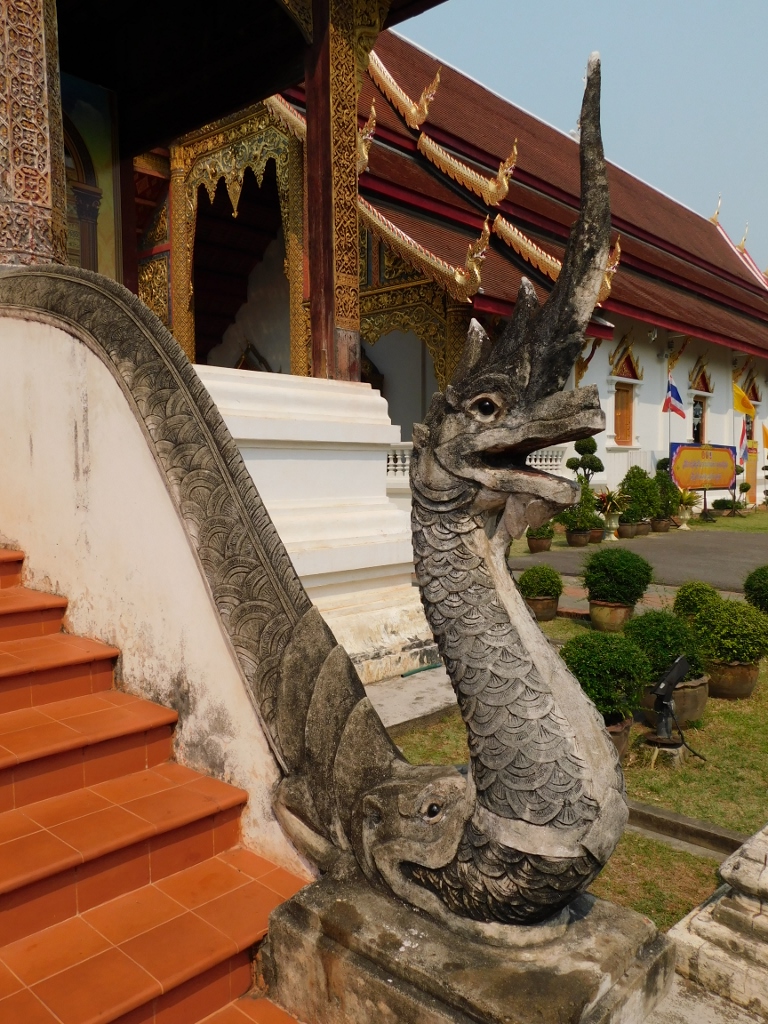 Wat Phra Singh, ubosot, a detail
Wat Phra Singh, ubosot, a detail
I paid a bit more attention to the main chedi and the southern smaller chedi before embarking on a visit to vihara Lai Kam.
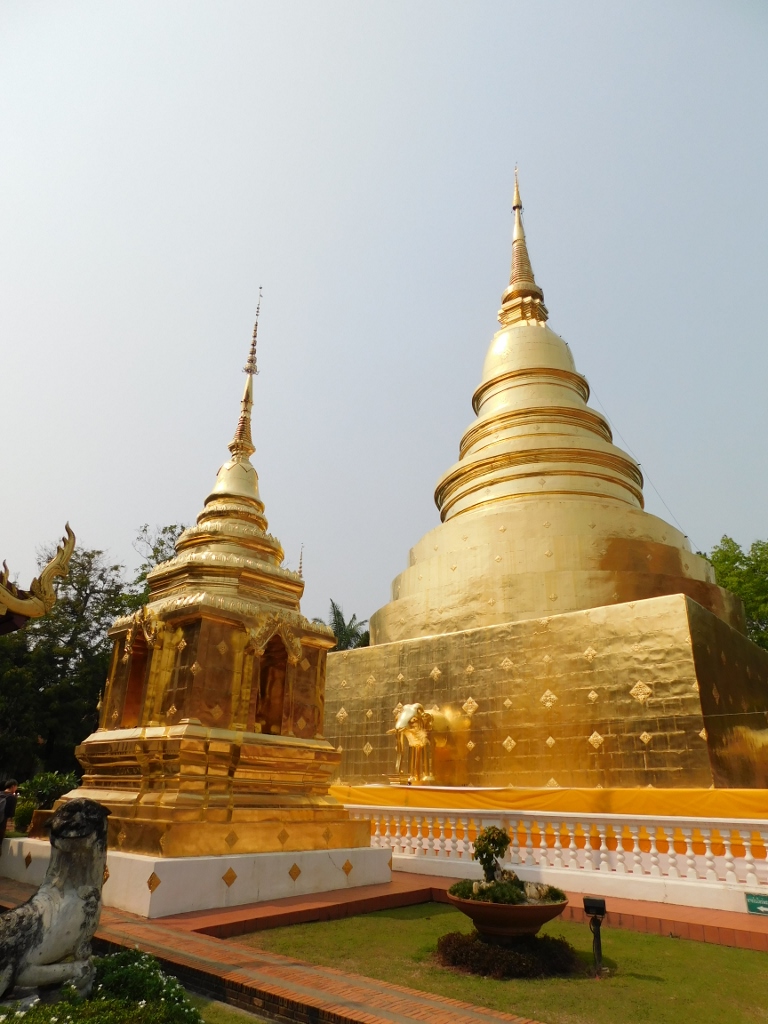 Wat Phra Singh, the main chedi and the south small chedi
Wat Phra Singh, the main chedi and the south small chedi
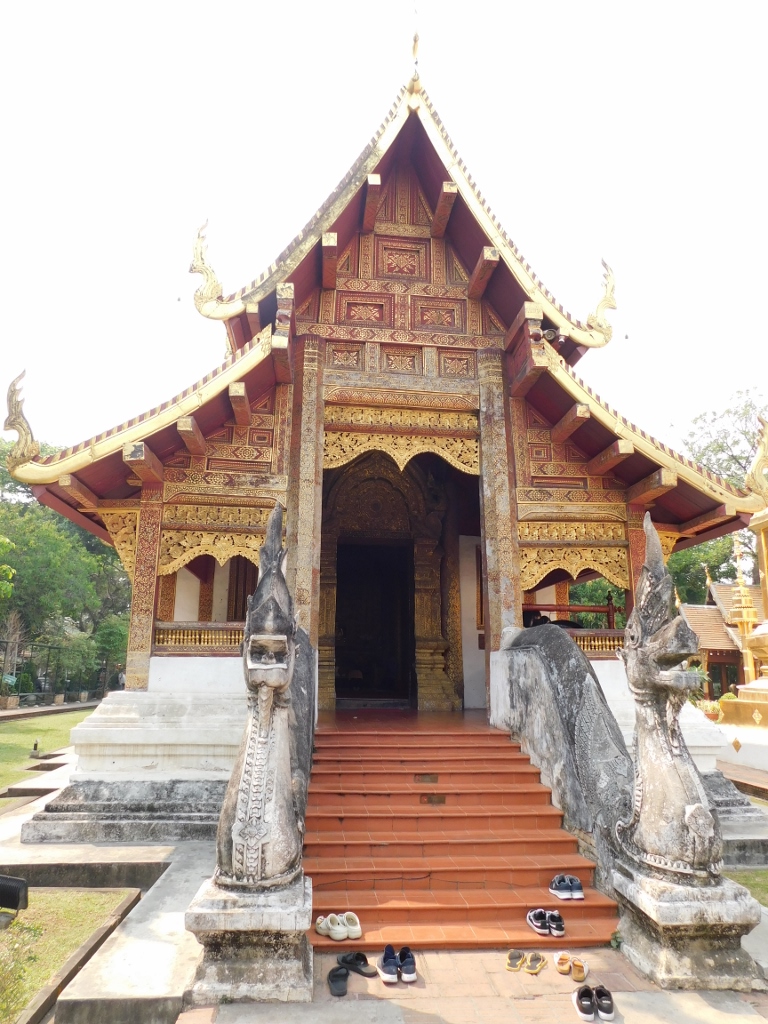 Wat Phra Singh: Vihara Lai Kham
Wat Phra Singh: Vihara Lai Kham
Vihara Lai Kham is considered one of the finest examples of the architectural style typical for the Lan Na kingdom. The structure is made from teak wood and the roof is constructed in three tiers (which may not be well visible in the previous photo, but can be seen in some others). The rich exterior decoration is done in gold and ochre colours. By the way, here too, the staircase is guarded by Nagas and Makaras, reaffirming the universal Buddhist symbolism.
The vihara was constructed in the late 14th century and houses a highly revered Buddha figure named the Phra Singh [Buddha], just like the temple itself.
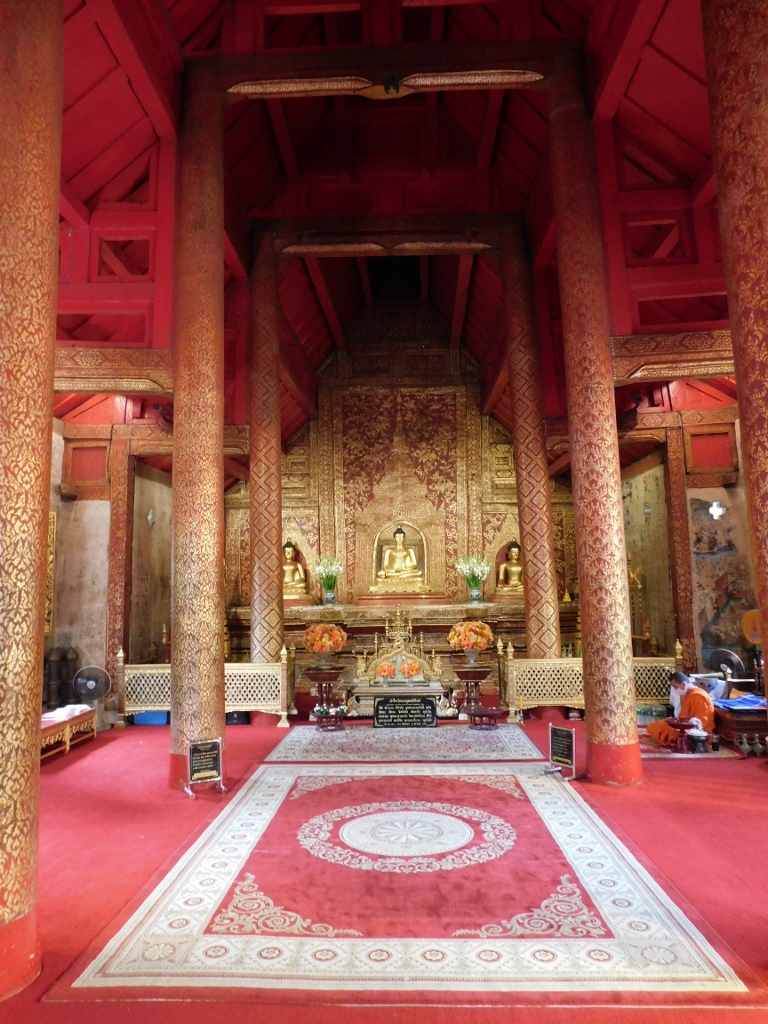 Wat Phra Singh: Vihara Lai Kham
Wat Phra Singh: Vihara Lai Kham
The temple complex actually had a different name until the year 1367. In that year, this sacred Buddha figure was brought here and the temple acquired its current name.
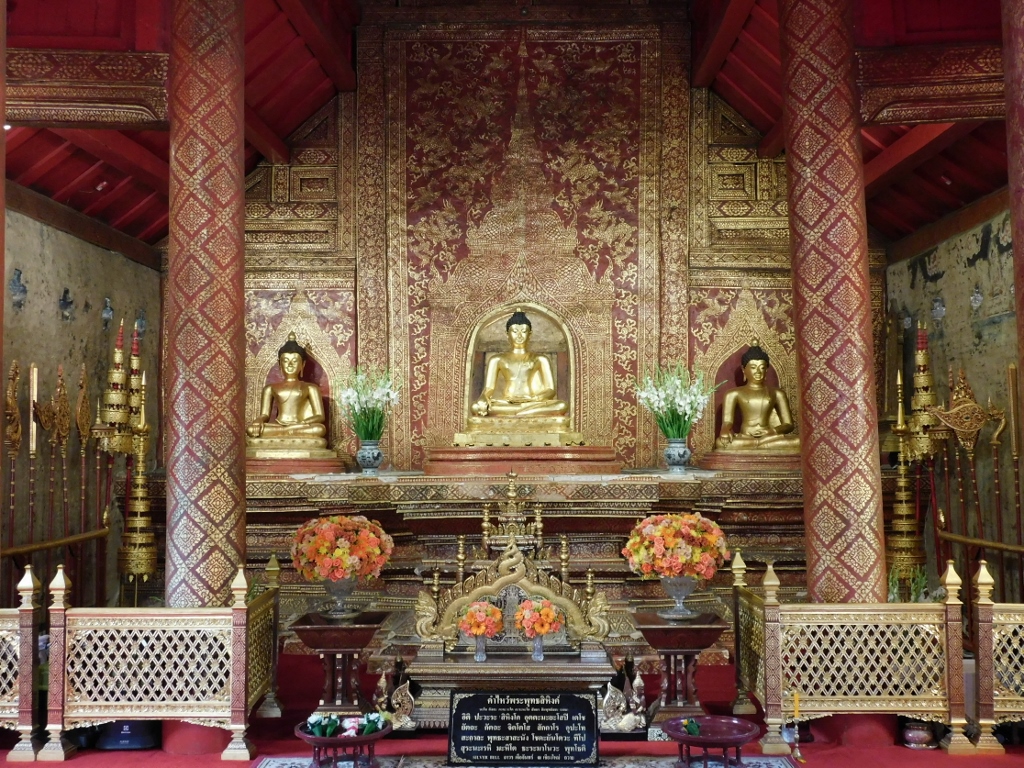 Wat Phra Singh: Vihara Lai Kham, a detail
Wat Phra Singh: Vihara Lai Kham, a detail
In addition to the rear wall behind the central figure of the Phra Singh Buddha, which has its specific decoration, the other walls are covered with murals painted in the first half of the 19th century.
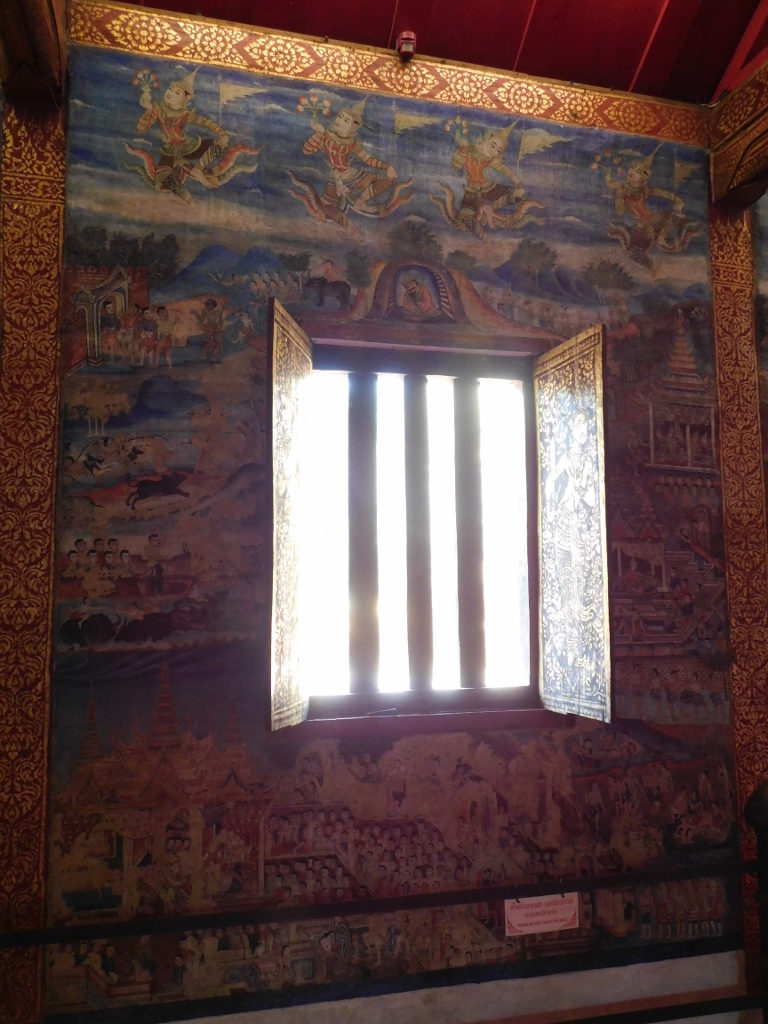 Wat Phra Singh: Vihara Lai Kham, a detail
Wat Phra Singh: Vihara Lai Kham, a detail
When I exited Vihara Lai Kham, I had a beautiful view of the ubosot and the large Vihara Luang.
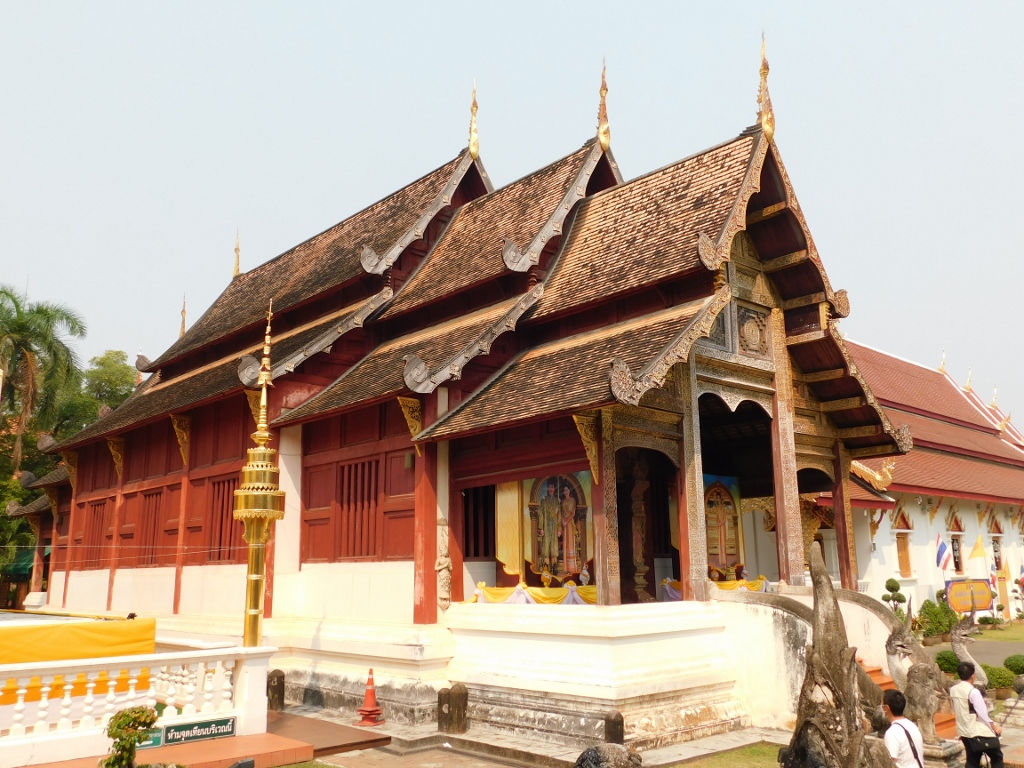 Wat Phra Singh, ubosot
Wat Phra Singh, ubosot
However, before heading to Vihara Luang, I once again captured the most significant parts of the temple complex.
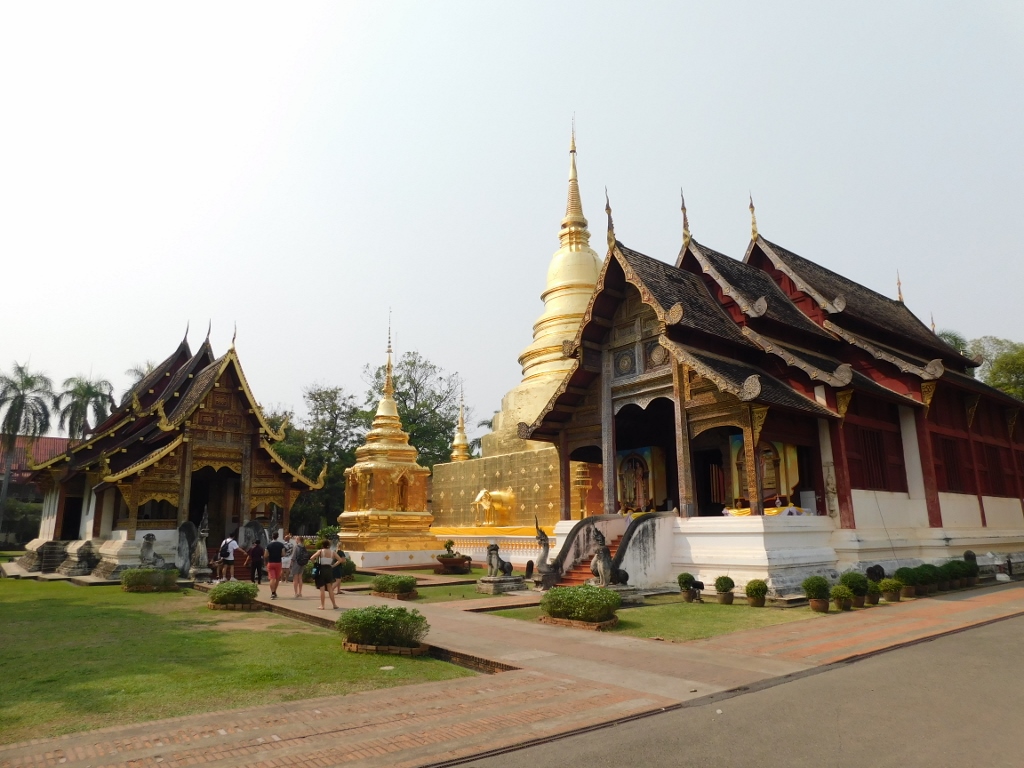 Wat Phra Singh: Vihara Lai Kham (left), the main chedi (middle) and the ubosot (right)
Wat Phra Singh: Vihara Lai Kham (left), the main chedi (middle) and the ubosot (right)
Now I could also visit Vihara Luang, which is the largest structure within the temple complex and was built in 1925, replacing the original vihara from the 14th century that once stood on this spot.
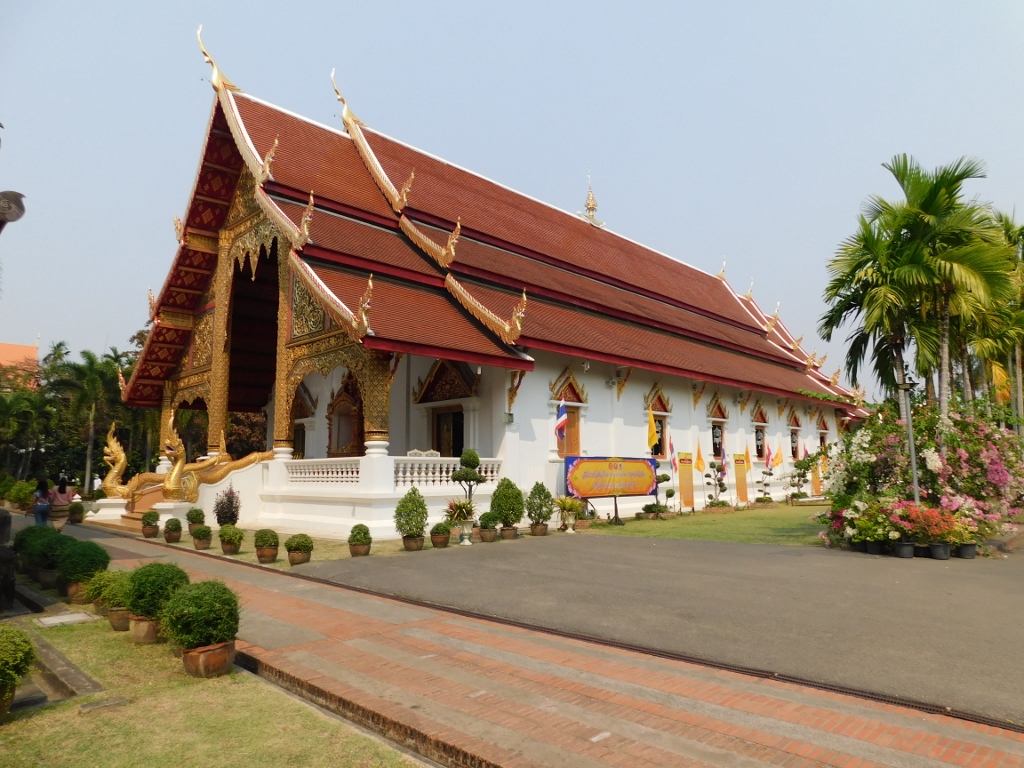 Wat Phra Singh, Vihara Luang
Wat Phra Singh, Vihara Luang
Like many other places I visited during my journey in Thailand, this one also had richly decorated and distinctive double doors. During my visits, some doors were closed and some were not, but, as it happens, it is only now that I illustrate this particular detail.
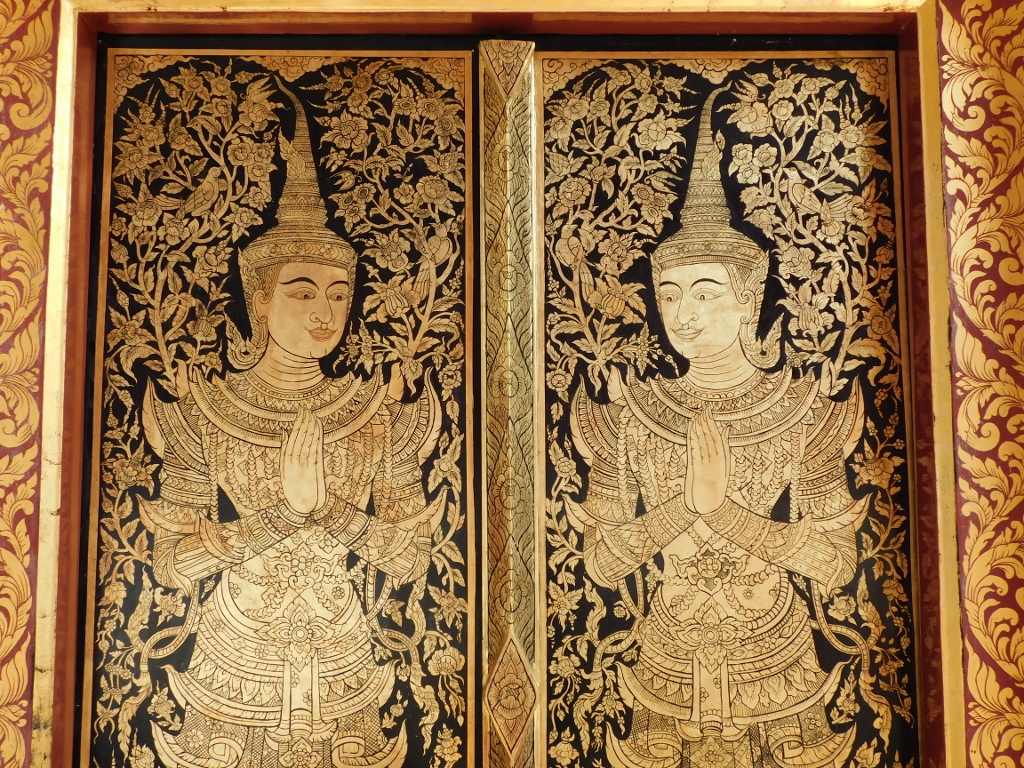 Wat Phra Singh, Vihara Luang, a detail
Wat Phra Singh, Vihara Luang, a detail
In this vihara, as well, there is a highly revered Buddha figure from the year 1477 and here I’m referring to the largest one, as seen in the following photograph.
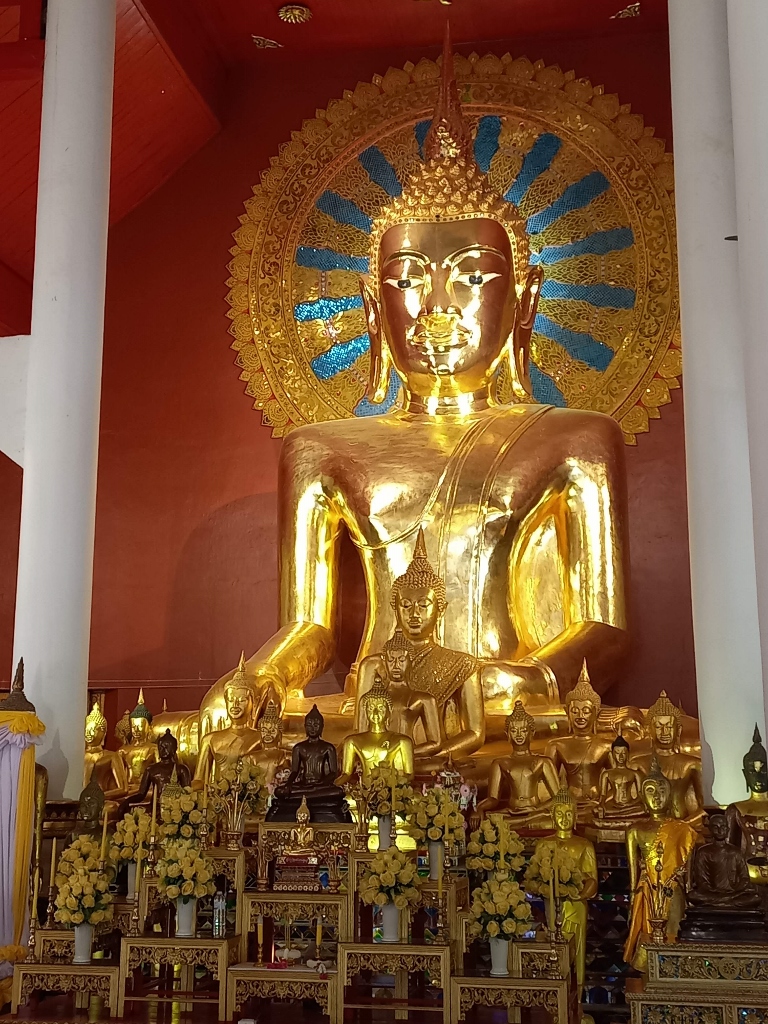 Wat Phra Singh, Vihara Luang, a detail
Wat Phra Singh, Vihara Luang, a detail
After visiting Vihara Luang, I walked to its eastern side facing a busy street just a few dozen metres away.
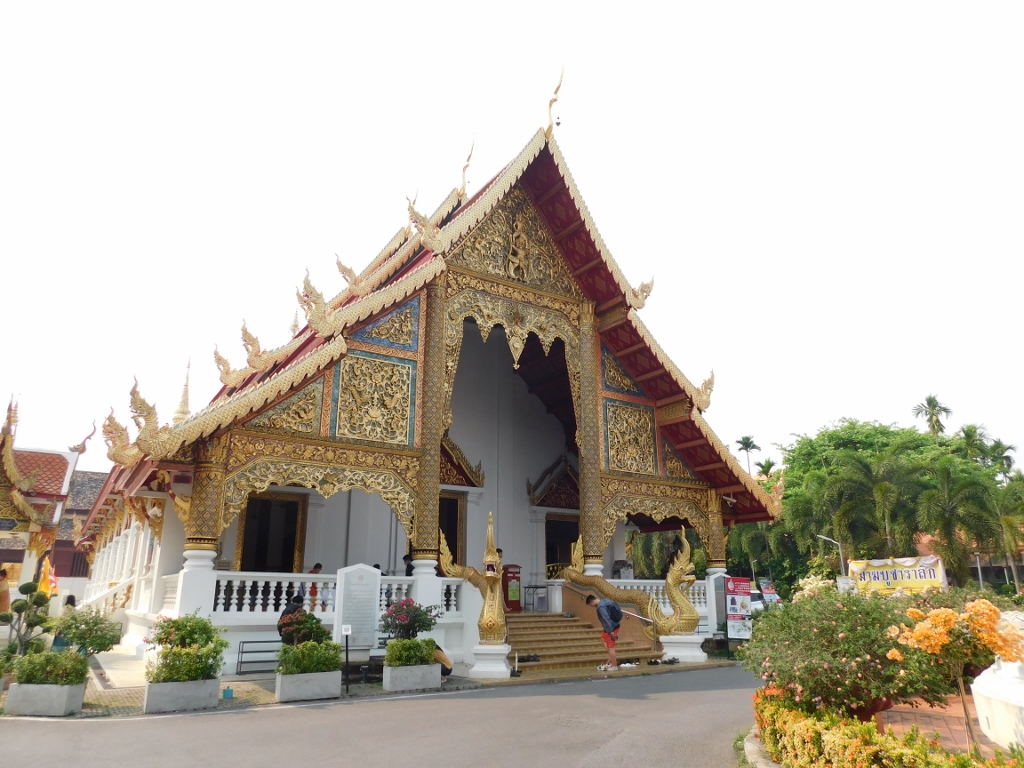 Wat Phra Singh, Vihara Luang
Wat Phra Singh, Vihara Luang
However, I still remained within the confines of the Wat Phra Singh temple because I wanted to see another very interesting structure, the temple library called Ho Trai.
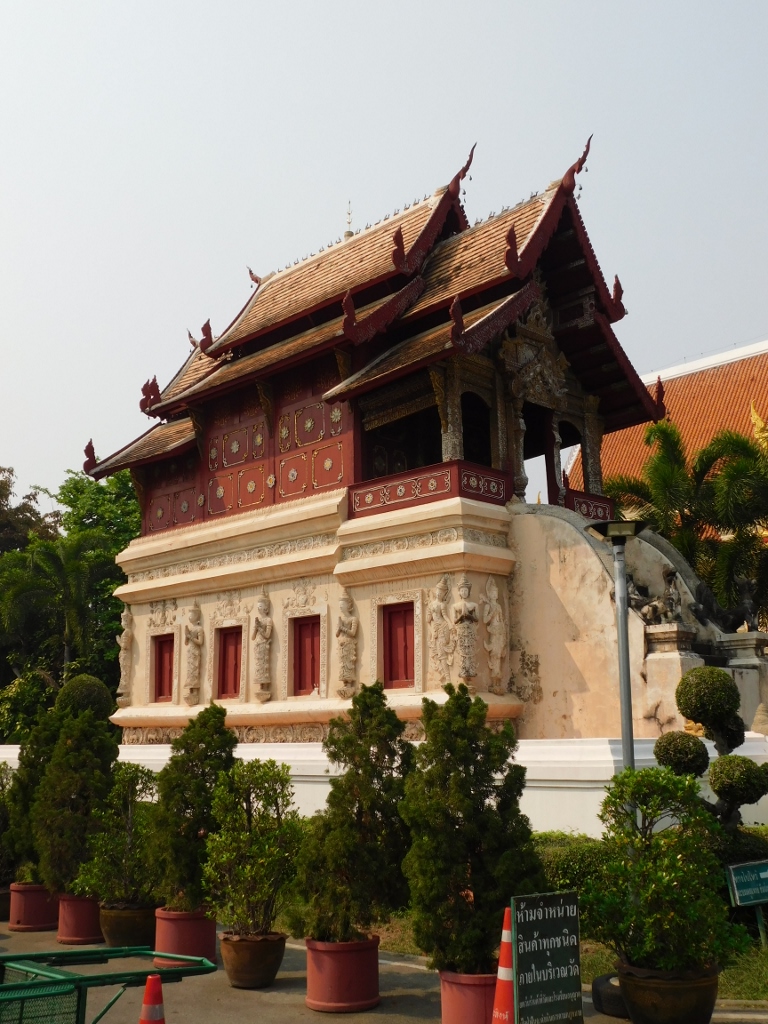 Wat Phra Singh, Ho Trai
Wat Phra Singh, Ho Trai
This structure also represents an outstanding example of the classical architecture in the Lan Na kingdom and is considered one of the most beautiful temple libraries in Thailand. The rectangular-plan library was built around 1497 and consists of two floors: the lower one made of bricks and covered with a rich layer of lime, while the upper floor is made of wood. The intricately crafted wooden roof is covered with earthenware tiles.
What’s particularly interesting is that on both sides of the stairs, there are lion figures emerging from the jaws of Makara, the mythical sea creature. This combination of a lion and a Makara, unlike the previously mentioned ones with a Naga and a Makara, is exceptionally rare.
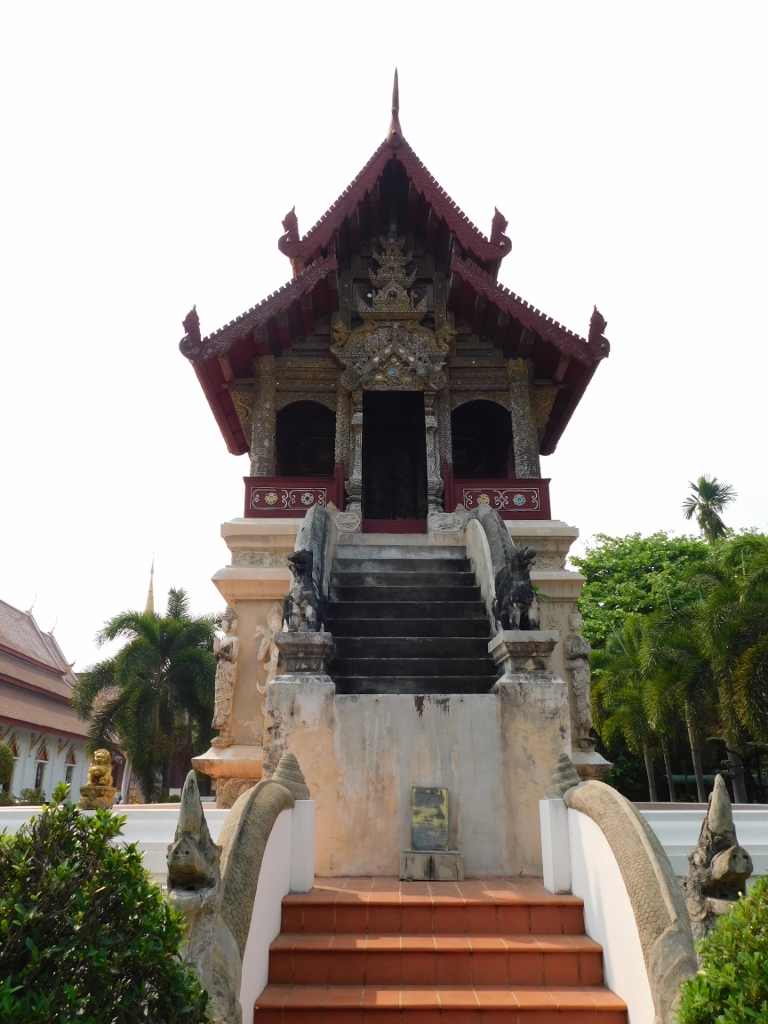 Wat Phra Singh, Ho Trai
Wat Phra Singh, Ho Trai
Now I walked around this small structure because it is truly fascinating from every angle.
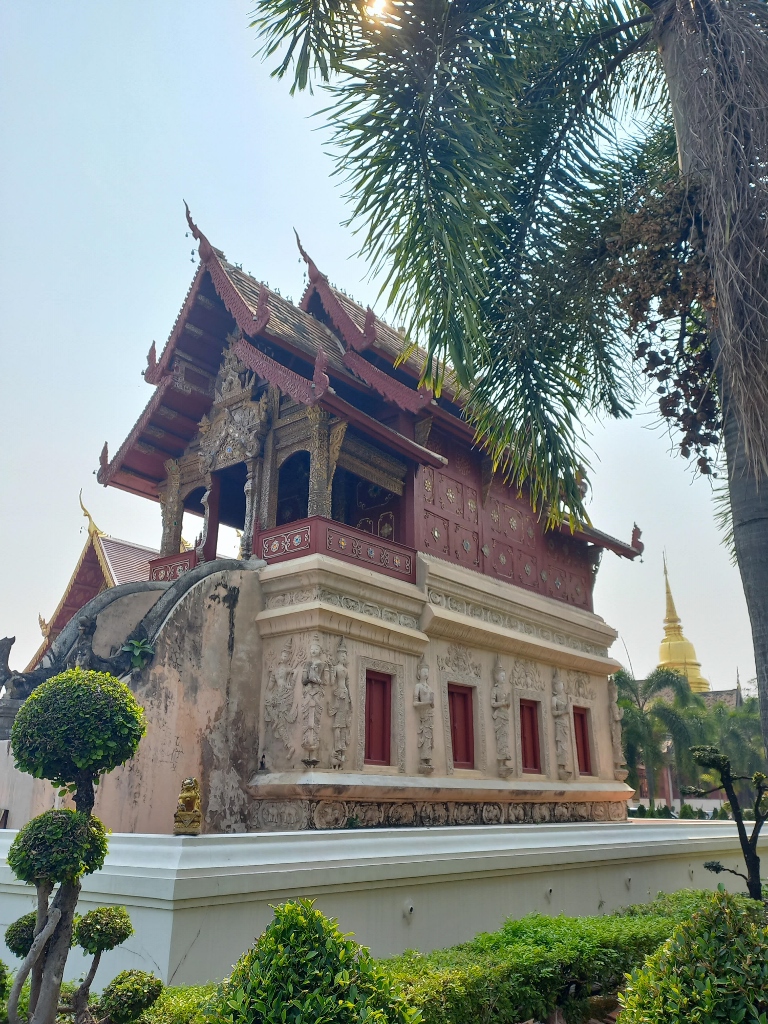 Wat Phra Singh, Ho Trai
Wat Phra Singh, Ho Trai
The exterior wall of the ground floor is decorated with 16 angel figures crafted in the stucco technique, along with a multitude of depictions of various animals and decorative elements. On the upper floor, what stands out is the floral decoration created as coloured glass mosaics.
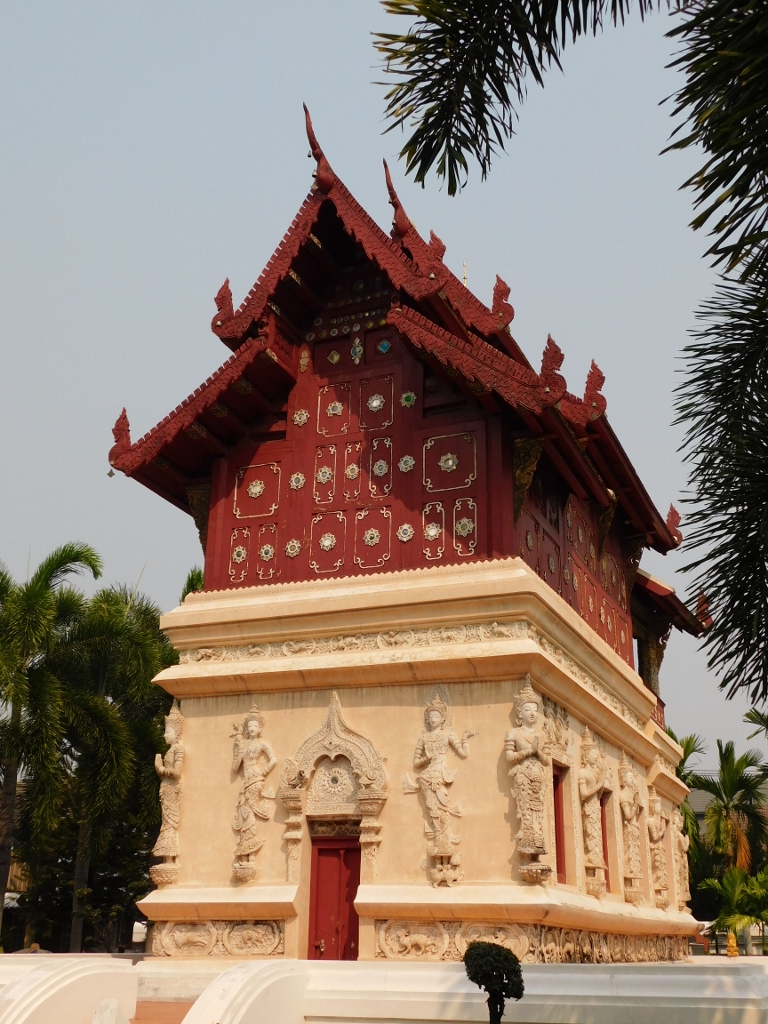 Wat Phra Singh, Ho Trai
Wat Phra Singh, Ho Trai
With this, I concluded a fairly detailed tour of the Wat Phra Singh temple and I was ready to continue further. Since I only had to walk for less than ten minutes, I didn’t even consider looking for the owner of the transportation seen in the next photo, with the inevitable bargaining that would ensue.
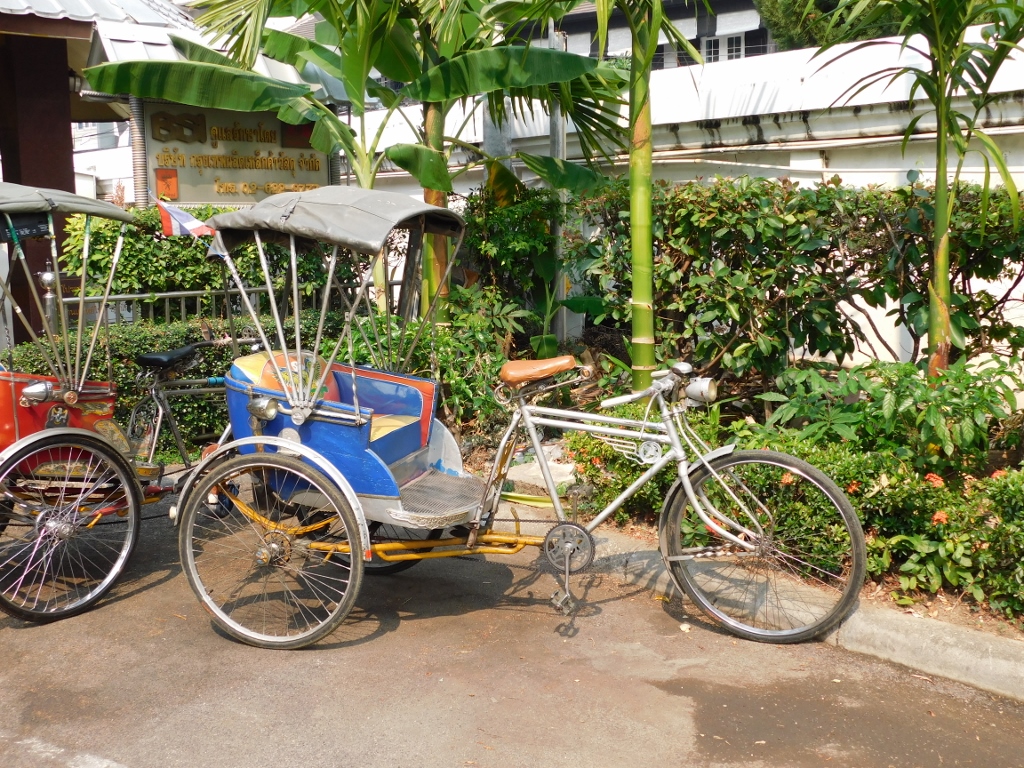 Potential public transportation in Chiang Mai
Potential public transportation in Chiang Mai
On the other hand, although the street wasn’t crowded and I tried to walk on its shaded side, it was afternoon, the temperature had reached its peak, and the asphalt and surrounding buildings were heated up. This meant I had to take more frequent breaks. So, I stopped at a café for a freshly squeezed mango and passion fruit juice, which is my favourite combination.
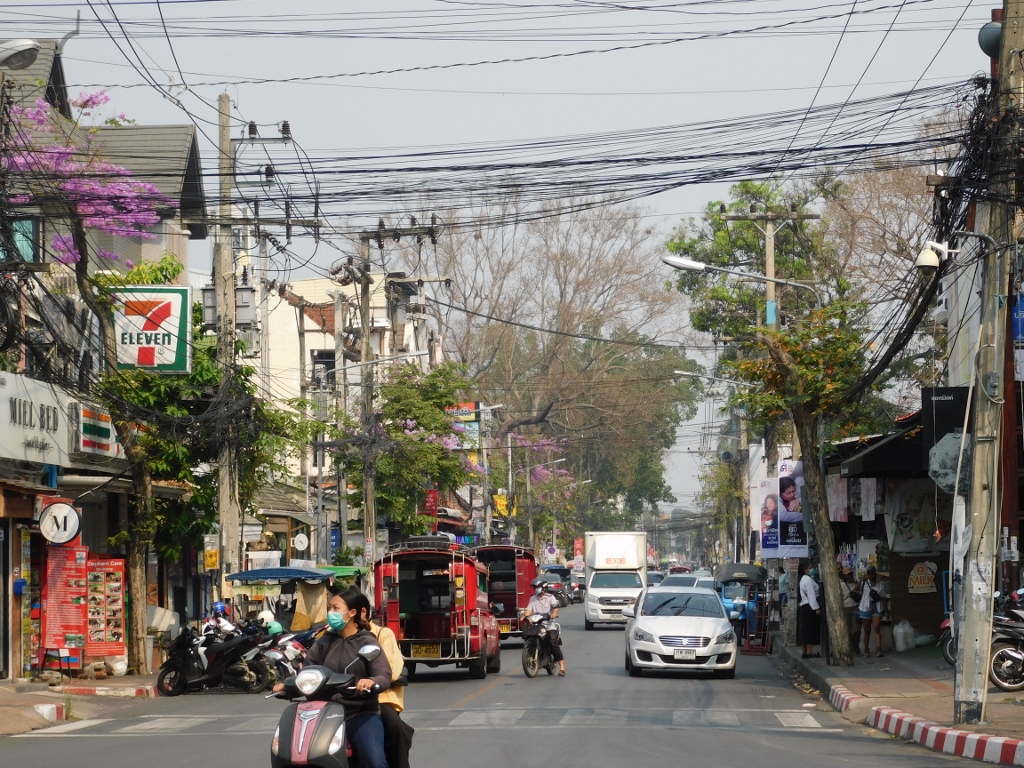 Hot afternoon in Chiang Mai
Hot afternoon in Chiang Mai
On my way, I saw and took photo of another version of public transportation. This time it was a tuk-tuk taxi parked beside another improvised shrine where a Buddha figure was placed.
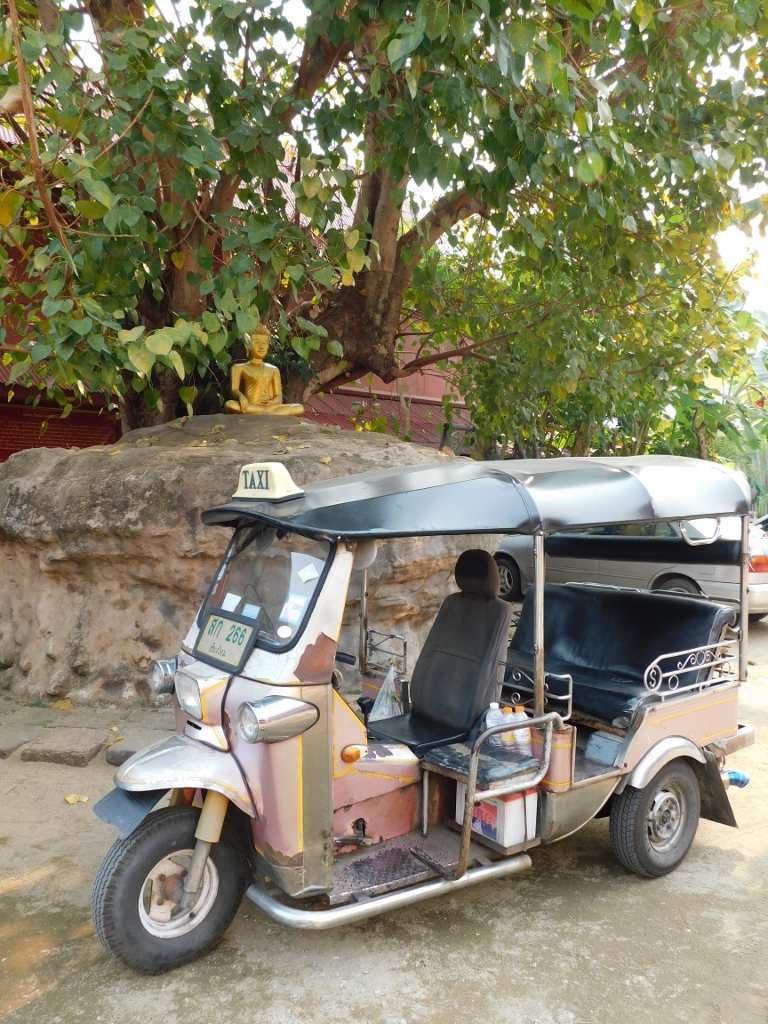 Public transportation in Chiang Mail comes in diverse forms
Public transportation in Chiang Mail comes in diverse forms
Now I also reached the Wat Phan Tao temple.
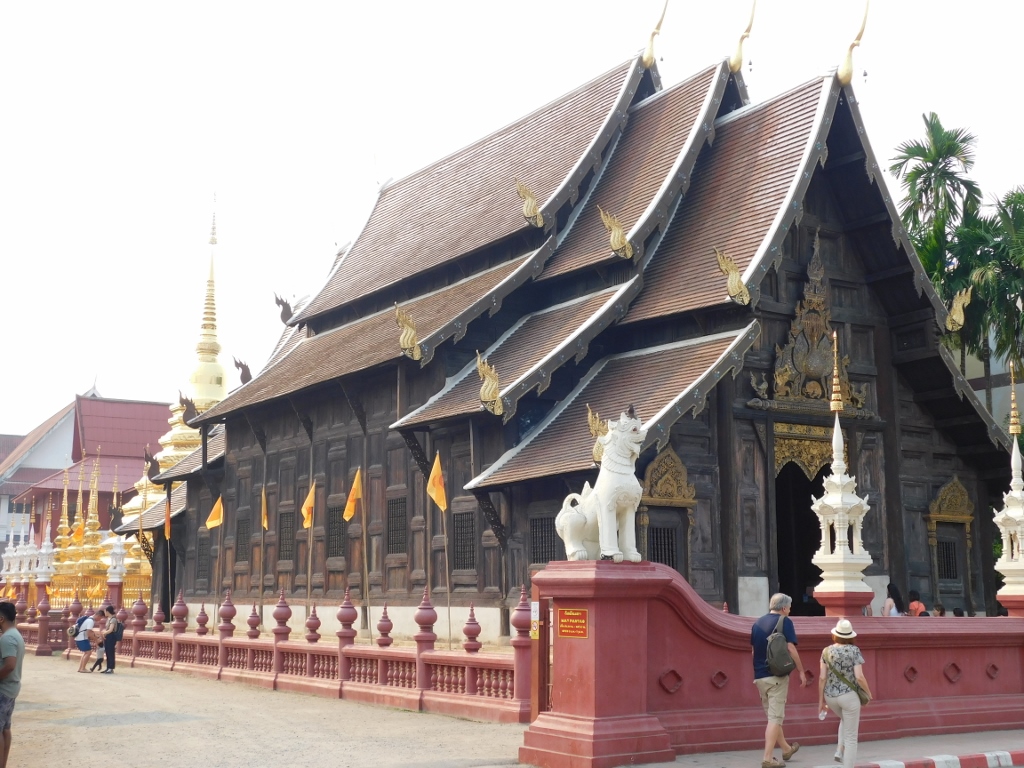 Wat Phan Tao
Wat Phan Tao
This is a temple founded at the end of the 14th century, but the vihara located right next to the street was constructed in 1876. As it can be seen, it is a structure entirely made of wood, specifically teak panels, and it is set on a stone base. Its impressive three-tiered roof, adorned with traditional finials called chofas, is also noteworthy. I haven’t mentioned this architectural decorative element earlier, but it is practically visible on the roofs of all temples. Chofa can resemble an elongated, slender bird and it is believed that in this form it represents Garuda, the vehicle of Hindu god Vishnu. This suggests its origin from the times when Hinduism dominated over Buddhism in this region. On the other hand, there are also other versions of chofa shaped like swans, fish and elephant heads, while here they are mostly in the form of Naga serpents (except those at the very top of the roof).
But, in the case of this temple, perhaps the most beautiful part is its front facade.
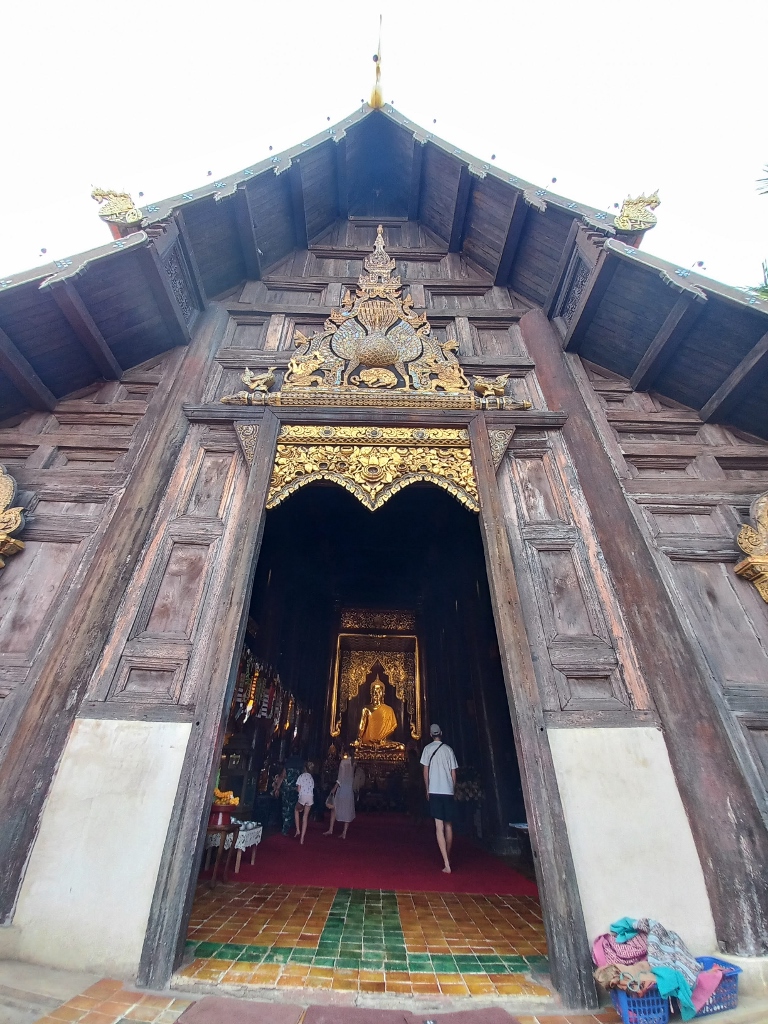 Wat Phan Tao, vihara
Wat Phan Tao, vihara
Not only are the wooden panels very beautiful in themselves, but above the doors, there is a gilded pelmet and, above that, the main figure of a gilded peacock with a crouching dog below it. There are also Nagas and other mythical beings. In addition to being gilded, these different parts are also inlaid with colourful glass.
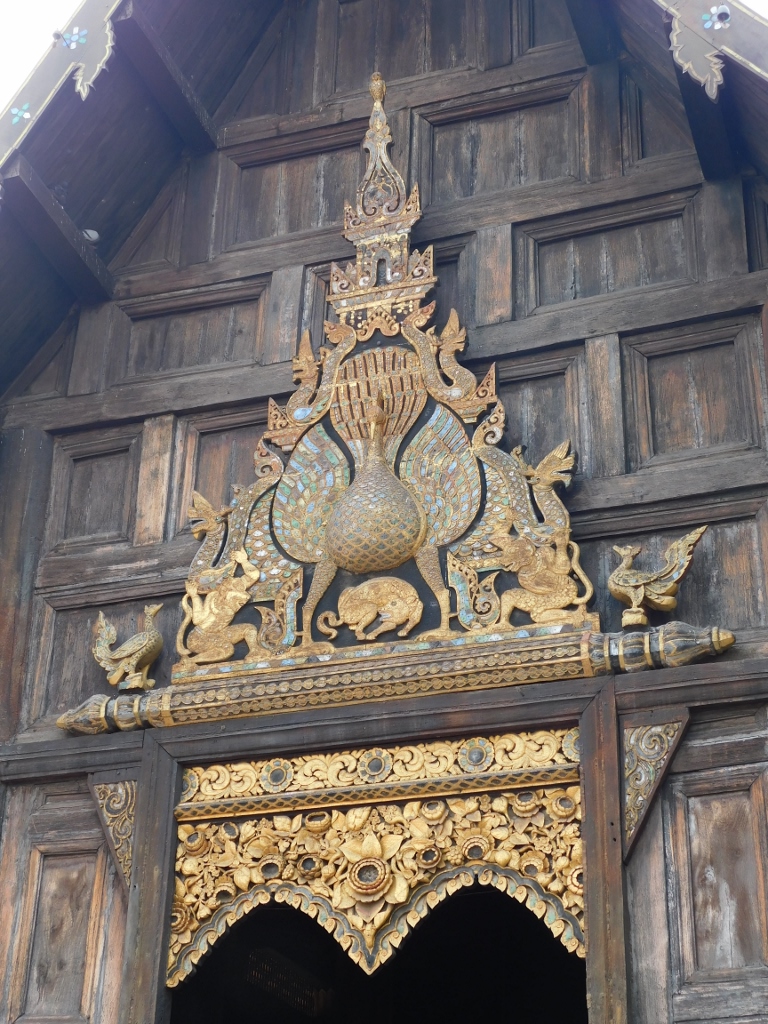 Wat Phan Tao, vihara, a detail
Wat Phan Tao, vihara, a detail
Inside, besides the Buddha figure, various other details can be seen, including massive teakwood columns that support the roof structure.
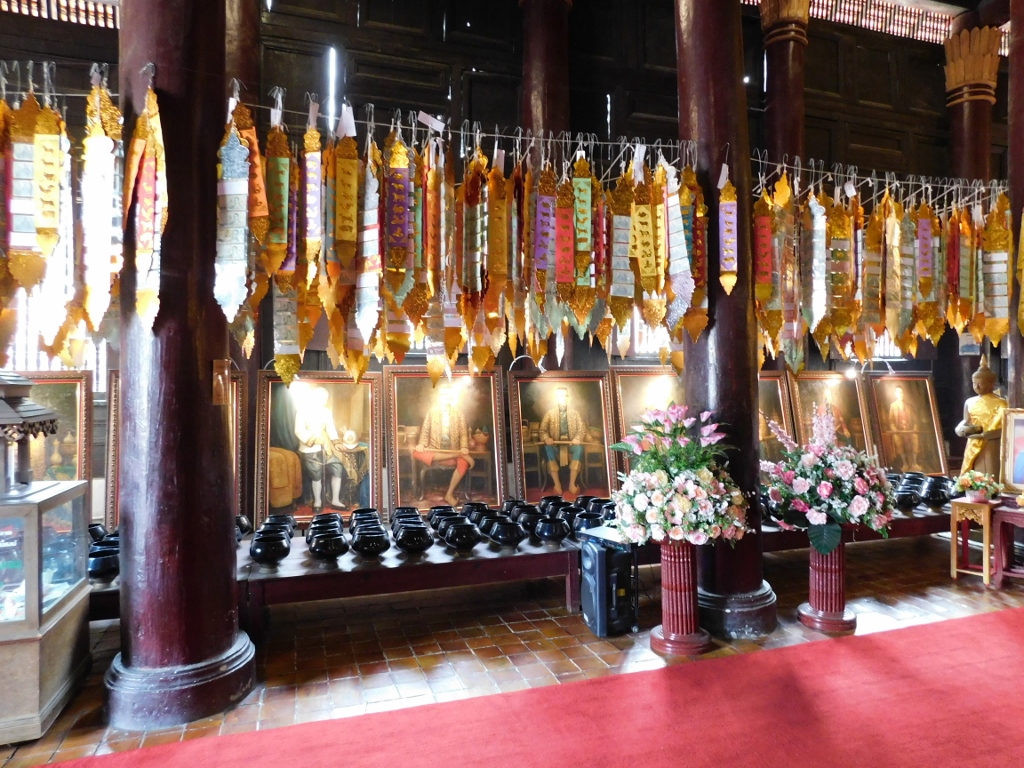 Wat Phan Tao, vihara, a detail
Wat Phan Tao, vihara, a detail
This temple is not large and, behind it, there is a chedi that was repainted with golden colour in recent years.
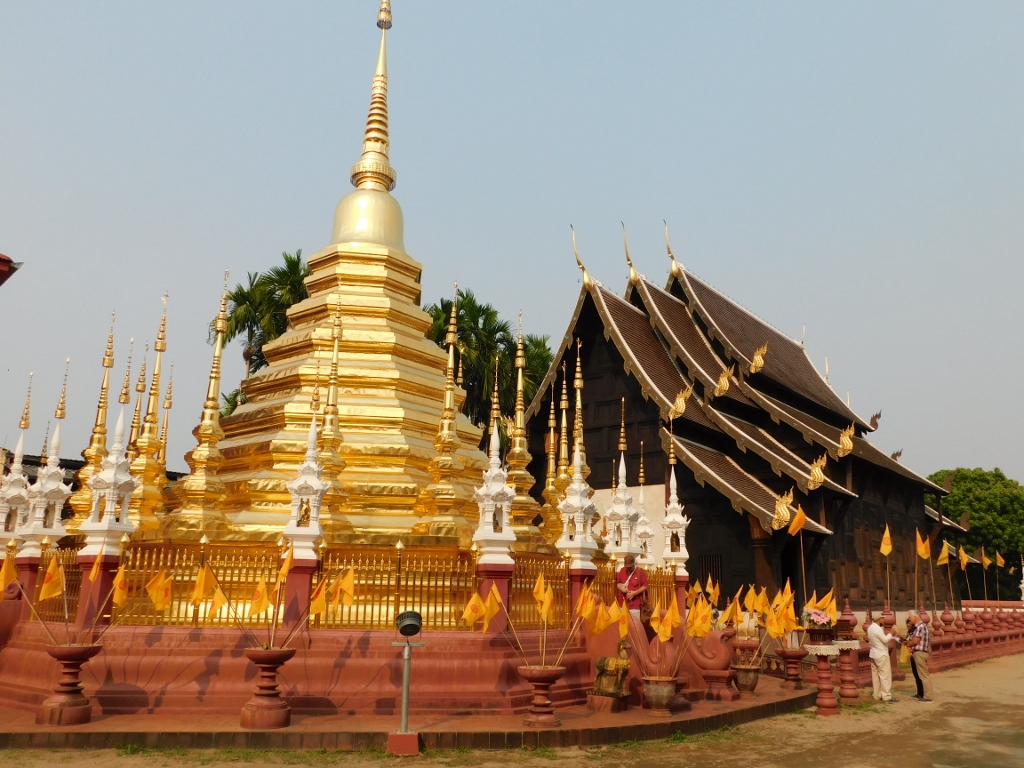 Wat Phan Tao
Wat Phan Tao
After this brief visit to the Wat Phan Tao temple, I moved just a hundred metres south because there is another significant temple there, Wat Chedi Luang. But, I’ll share more about that one the next time.